
93 minute read
REMARKABLE RARITIES

“I Am A Man”—the iconic slogan of the Civil Rights Movement

3001. Original ‘I Am a Man’ Poster. Historic original “I Am A Man” poster printed in 1968 by the Tea Lautrec Litho print shop, 22 x 28, with “Memphis” underneath the prominent main text. Bottom left corner has: “tea lautrec litho - san francisco.” Bottom right corner has: “(c) 1968 Emerson Graphics - 243 Collins Street. San Francisco 94118 / Mail Order $1.25 (Quantity Prices On Request).” Framed to an overall size of 23.25 x 29. In fine condition.
The “I Am A Man” poster was made famous with the Memphis sanitation strike of February–April 1968. Shortly after two workers, Echol Cole and Robert Walker, were crushed to death in the back of their garbage truck, as many as 1,300 black sanitation workers in Memphis walked off the job in protest of horrible working conditions and racist discrimination by the city. Martin Luther King, Jr. traveled to Memphis to support the strike as part of his Poor People’s Campaign, speaking before a large crowd on March 18th and leading a mass demonstration on the 28th. Mayor Henry Loeb III imposed martial law and brought in 4,000 National Guard troops. The following day, over 200 striking workers continued their daily march, carrying the iconic signs that read: “I Am A Man.” The slogan emerged as a unifying theme, and this poster has become one of the enduring images of the Civil Rights Movement. Starting Bid $500
Presented to Philadelphia’s first black deputy police commissioner

3002. Martin Luther King, Jr. Signed Photograph.
Wonderful vintage semi-glossy 6 x 7.75 photo of Reverend King, his lapel bearing a pin that reads, “I Believe in Human Dignity,” signed and inscribed in black ballpoint, “To Captain Edwards, With Warm Personal Regards, Martin Luther King, Jr.” Archivally matted and framed to an overall size of 9.25 x 11. In very good to fine condition, with a tape stain to the upper left corner, a light scuff to King’s cheek, and light rippling to the bottom. Accompanied by a full letter of authenticity from PSA/DNA and a letter of provenance from the son of the recipient, stating that this “signed photo was a gift to my late father, Richard T. Edwards, during the mid-1960s. Dr. King presented this autographed photo to Captain Edwards for directing the security detail on his visits to Philadelphia. In 1964 my father was named Deputy Police Commissioner of Philadelphia, the first African-American to ever achieve such position.” Starting Bid $500
The liberation of Malcolm Little— parole certificate from the Commonwealth of Massachusetts


3003. Malcolm X Document Signed. DS, signed “Malcolm Little,” one page both sides, 8.5 x 11, August 7, 1952. A certificate of parole from the Commonwealth of Massachusetts, which reads, in part: “It having been made to appear to the Massachusetts Parole Board that Malcolm Little, No. 22843, a prisoner sentenced to the State Prison is eligible to be paroled, and the matter having been given careful consideration, it is, therefore, ordered by the said Parole Board that the said prisoner be released on parole and permitted to be at liberty during the unexpired portion of the sentence.” Signed on the reverse in blue ballpoint, “Malcolm Little,” who has mistakenly added a partial signature above. In overall fine condition. Starting Bid $500
Original 1946 “Mass State Prison” mug shot of Malcolm X

3004. Malcolm X Original Mug Shot. Original semiglossy 4.75 x 3 ‘mugshot’ or booking photograph of Malcolm Little from February 1946, with the reverse bearing a “Massachusetts State Police” description stamp, filled out in black ink: “No. 105869,” “Date of Photo: 1946,” “Name: Malcolm Little,” “DOB: 5-19-25,” “Place: Omaha, Nebraska,” “Height: 6´ 2˝,” “Weight: 172,” “Hair: Lt. Brn,” “Eyes: Brn,” “Comp: Negro,” “Build: Slender,” “Dept: S.P.,” “Date: 2-27-46,” “Charge: B&E…& Lar. (4 cts),” and “Remarks: 1946 Description.” In fine condition, with light corner creasing and staple holes to the left edge. Starting Bid $500
Presidential flag from the limousine of Dwight D. Eisenhower

Flag. Flag of the President of the United States which flew over the driver’s side front fender of the modified Lincoln Cosmopolitan presidential state car of Dwight E. Eisenhower in 1960. Handmade by the Philadelphia Quartermaster Depot, the field of the flag measures 28.5˝ x 18˝ and is constructed of navy blue nylon wool bunting, trimmed around the three flight edges with a hand-knotted 1.5˝ fringe of alternating gold and white thread. The eagle at center comprises a single piece of white fabric appliqué, detailed with textile paint. The inner hoist features the original fabric maker’s label, which reads: “Flag, Dist., Pres. / Nylon & Wool Bntg. / W / Fringe 1´ 6˝ x 2´ 2˝, Item 2 Job 6279, DTD 9-7-60 / P.Q.M.C. [Philadelphia Quartermaster Corps], MFG. DIV.” The flag inspector has added their initials “JMQ” and the number “4” to this label in faint black ink, and the interior hoist also features soft brown leather tabs to top and bottom, with the name “Roy” in black ink. Additionally, the hoist contains a small slip of cardstock with ink and pencil notations, “Pressed R,” and “Check Olives Arrows.” In fine condition, with a few small holes to lower hoist. The materials, dimensions, and manner of construction seen on this flag fully comply with the guidelines laid down by the U.S. Army Institute of Heraldry’s “Drawing No. 5-1-18” of July 20, 1967, a copy of which is provided with this lot. Accompanied by a letter of provenance from the son of the original recipient, who was presented with this flag as a token of thanks by a White House military advisor, circa 1975-1978. Starting Bid $1000
Hawaiian statehood drawing signed by Ike and his White House staff

3006. Dwight D. Eisenhower and Staff Signed Drawing.
One-of-a-kind original drawing by Earle D. Chesney presented to Robert E. Merriam, the Deputy Assistant to the President, in commemoration of Hawaii’s admission into the United States of America, signed in the lower border in fountain pen by President Dwight D. Eisenhower, and in various ink types by 46 members of his White House staff. Accomplished in pencil, ink, and watercolor on an off-white 14.5 x 21.75 sheet, the artwork depicts Merriam with two books and holding an American flag as he daydreams of a hula-dancing elephant with quote above: “By Golly, I Didn’t Think I Could Swing It.” A handwritten caption to the upper left reads: “When the President signed the Proclamation admitting Hawaii into the State of the Union, (4:00 P.M. Friday, Aug. 21, 1959) it was of great historic significance—for the first time in 158 years there would not be a delegate in the membership of the Congress of the United States.” Signed by the artist, who dates the drawing to December 14, 1959. Staff signatures available online. Framed to a slightly larger size and in fine condition. Starting Bid $200
Air Force One preflight report signed by JFK, plus a 1962 bill signing pen
3007. John F. Kennedy. Remarkable pairing of Kennedy items from the estate of Senator Eugene McCarthy’s secretary, including a signed Air Force One preflight report and a bill-signing pen:
The “Preflight Report” for President Kennedy’s flight from Andrews Air Force Base to Stewart Air Force Base on September 24, 1963, filled out and signed by Air Force One commander Col. James B. Swindal, one page, 5 x 8, signed in various inks by the president and members of his flight party: John F. Kennedy, Eugene McCarthy, Hubert H. Humphrey, Stewart Udall, Dave Powers, Ken O’Donnell, and Gaylord Nelson. A typed cover letter memo, dated September 27, 1963, is stapled to the upper left corner: “For: Gene McCarthy, From: Hubert Humphrey, Here is the Preflight Report signed by J.F.K.”

The classic ‘bill signer’ Esterbrook dipping pen was used by President Kennedy to sign a “Wild Life Conservation bill,” according to a contemporary laminated newspaper clipping [presumably the amendment to the Soil Conservation and Domestic Allotment Act to limit the drainage of wetlands, signed on October 2, 1962]. The included newspaper clipping, under the headline, “Local Woman Has Pen Used By President,” reads, in part: “The distinctive pen used by the President formed one stroke of the Chief Executive’s signature as he put into law the Wild Life Conservation bill on Oct. 2.” In overall fine condition. Starting Bid $300

The rarest presidential free frank

3008 . Franklin D. Roosevelt Free Frank. Tremendously rare free-franked White House ‘Official Business’ mailing envelope, 9.5 x 4, addressed in type to “Benjamin F. McLoud, Esq., 2217 Noble Street, West Lawn, Pennsylvania,” postmarked in Washington, D.C., July 27, 1933, and franked in the upper right in bold fountain pen by President Franklin D. Roosevelt. In fine condition. Presidents of the United States enjoyed the franking privilege until 1873, when after much official abuse, it was abolished. Although Congress granted itself the frank only two years later, it was never granted again to a sitting president of the United States. According to late autograph dealer Charles Hamilton, only two envelopes franked by Roosevelt were known to exist, both of which were owned by the same collector, who ‘because he had done an important political favor for F.D.R., was the owner able to persuade the President—to use F.D.R.’s words—’to break the law’…The signature of Roosevelt…is the rarest of all Presidential franks.’ Starting Bid $300
Five days after JFK’s assassination, LBJ thanks the governor of Delaware for “solace in this tragic hour of our Nation’s history”
3009. Lyndon B. Johnson Typed Letter Signed. Significant TLS as president, one page, 6.75 x 8.75, White House letterhead, November 27, 1963. Letter to Delaware Governor Elbert N. Carvel, in full: “I deeply appreciate your kind expression of solace in this tragic hour of our Nation’s history. In the days ahead, I will need your continued prayers and support.” In fine condition, with light toning to the upper part of the letter, and some light creasing along the central horizontal fold. Starting Bid $500
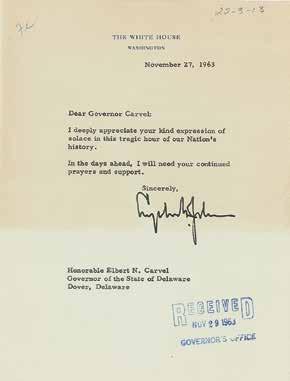
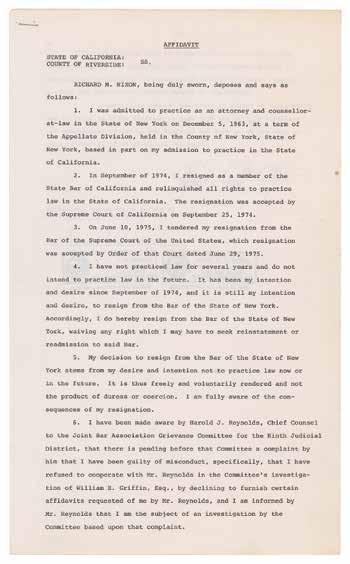

3010. Richard Nixon Document Signed. DS, signed “Richard M. Nixon,” two pages, 8.5 x 14, January 23, 1976. Affidavit issued by Richard Nixon in an attempt to resign from the Bar of the State of New York. In part: “I have not practiced law for several years and do not intend to practice law in the future...Accordingly, I do hereby resign from the Bar of the State of New York, waiving any right which I may have to seek reinstatement or readmission to said Bar.” Signed at the conclusion in black ballpoint by Nixon. In fine condition. Accompanied by a signed affidavit of procurement. Starting Bid $200
“When in the course of human events...”— the first British printing of the Declaration of Independence
3011. First Foreign Printing of the Declaration of Independence. Complete original issue of The London Chronicle from August 15–17, 1776, eight pages, 8.25 x 11.5, containing the first foreign printing of the Declaration of Independence. The text of the historic document appears on the fourth page, published without comment, under the heading: “Advices from America, In Congress, July 4, 1776, A Declaration by the Representatives of the United States of America, in General Congress Assembled.” Other revolutionary news concerns a sea battle off Antigua involving the 28-gun provincial ship of war Revenge, and an English sloop of war “homeward bound with powder and other valuable articles,” a convoy from Jamaica to sail with the English fleet, the suffering of the English soldiers at Bunker Hill, maneuvers of the French fleet, and military action on Staten Island and the removal of General Washington’s headquarters “upon the discovery of a design to seize and deliver his person to Governor Tryon.” In fine condition. Starting Bid $300

As Congress President, Laurens transmits “two Acts of Congress” to a Delaware signer in 1778

3012. Henry Laurens Letter Signed. Notable LS signed “I have the honor to be, With great Respect, Sir Your Excellency’s Most obedient Servant, Henry Laurens, President of Congress,” one page, 8 x 13, October 7, 1778. Written from Philadelphia, an official letter to Cesar Rodney, the “President of the State of Delaware,” in full: “I had the honor of addressing your excellency on the 5th Ult’o since which have not received any of your favors the present serves to transmit two Acts of Congress viz.
1…of the 2nd Instant for continuing the present Embargo on Provision until the last day of January 1779, and for divers other purposes therein mentioned.
2…An Act of the 5th Inst. for exchanging with Continental Currency such local Bills of Credit as have been received in the Loan Office of each State respectively.” In fine condition, with several red underlines, added in an unknown hand. Starting Bid $300
Thick lock of Lincoln’s hair, with historically significant blood-stained telegram

3013. Abraham Lincoln Lock of Hair and ‘Bloody’
Assassination Telegram. Thick lock of Abraham Lincoln’s hair removed during his postmortem examination, measuring approximately 2˝ long, presented to Dr. Lyman Beecher Todd, a cousin of Mary Todd Lincoln. The hair is mounted to an official War Department manuscript telegram sent to Dr. Todd by George H. Kinnear, his assistant in the Post Office at Lexington, Kentucky, received in Washington at 11 PM on April 14, 1865; a typed caption prepared by Dr. Todd’s son reads, in part: “The above telegram…arrived in Washington a few minutes after Abraham Lincoln was shot. Next day, at the postmortem, when a lock of hair, clipped from near the President’s left temple, was given to Dr. Todd—finding no other paper in his pocket—he wrapped the lock, stained with blood or brain fluid, in this telegram and hastily wrote on it in pencil: ‘Hair of A. Lincoln.’” The telegram is impressively matted and framed alongside a letter from Dr. Todd’s son, James A. Todd, explaining the history of the relic, and images of Lincoln, Dr. Lyman Beecher Todd, and James A. Todd, to an overall size of 25 x 31. In fine condition.
In his 1937 work Why was Lincoln Murdered?, Otto Eisenschiml suggests that Secretary of War Edwin M. Stanton plotted to kill Lincoln due to their political and personal differences, and claims that he took steps to disrupt military communications in Washington, thus allowing John Wilkes Booth to escape. This telegram is of great historical significance, as it proves that military telegraph lines were up and running at 11 o’clock on the night of April 14th. Edward Steers, Jr. cites this very telegram in refuting Eisenschmil’s theory in his book Blood on the Moon: The Assassination of Abraham Lincoln. Starting Bid $10000

3014. Truman, Churchill, and Stalin Signature
Display. Significant assemblage of ink signatures from the Grand Alliance leaders of late World War II—Harry S. Truman, Winston Churchill, and Joseph Stalin—penned on individual off-white slips ranging in size from 2.25 x .5 to 3.5 x .5. Matted together with a photo of the three men at the 1945 Potsdam Conference and framed to an overall size of 10.25 x 12.75. In overall fine condition. The ‘Big Three’ met at the Potsdam Conference in July–August 1945 to determine the administration of postwar Germany. They came to various agreements relating to the German economy, punishment for war criminals, land boundaries, and reparations. The principal outcome was the decision to divide Germany into three zones of occupation (one for each nation), and to defer discussions of German reunification until a later date. Starting Bid $500
Oversized and unusually early portrait of Chiang Kai-shek
3015. Chiang Kai-shek Signed Oversized Photograph. Extraordinary oversized vintage matte-finish 8.5 x 10.75 photo of Chiang Kai-Shek in uniform, affixed to its original 11.25 x 14.5 mount, boldly signed and inscribed on the mount in ink by Chiang Kai-shek. An English inscription in the lower bor

der, penned in another hand, reads: “To Mr. Charles Clason, Nanking, 1947.” In fine condition, with a strip of toning along the top edge, and a trivial stain to the bottom edge. A superlative portrait of the Chinese leader, scarce in this large-format size. Starting Bid $200
Oversized formal presentation portraits of Hirohito and Nagako

3016. Emperor Hirohito and Empress Nagako. Magnificent vintage matte-finish 6 x 8.75 portraits of Emperor Hirohito and his wife Princess Nagako Kuni, depicting the heads of Japanese state in handsome three-quarter-length poses, both beautifully signed in bold black ink. The portraits are matted to their original display mounts, both of which measure to a

size of 10 x 13. In overall fine condition, with some light edge rippling, and light silvering. A scarce few Hirohito portraits are made available to the collecting public, particularly those of this quality and size—this is among the largest Hirohito photos that we have ever offered. Starting Bid $500
Patton signs for his security officer in December 1945
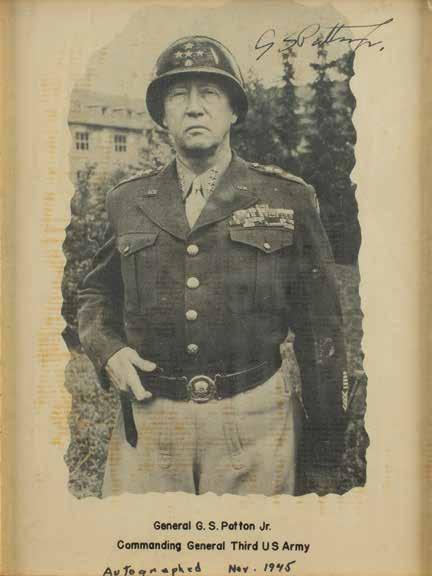
3017. George S. Patton Signed Photograph. Exceptional vintage 7.75 x 10 paperstock photo of General Patton removed from a booklet entitled ‘Third Army: A Brief History of Operations in Europe,’ signed in the upper right in fountain pen, “G. S. Patton, Jr.” The photo shows Patton in a distinguished half-length pose, looking sternly into the camera and wearing battle dress with his combat helmet exhibiting his four-star rank. Lower border of photo is annotated in black ink: “Autographed Nov. 1945.” Cloth-matted with an engraved plaque that reads: “Shortly before his tragic accident Dec. 9, 1945, General Patton autographed his likeness for 2nd Lt. John (‘Big John’) Papay, Officer in charge of security at Patton’s headquarters.” Framed to an overall size of 14.25 x 16. In very good to fine condition, with scattered horizontal stains. Accompanied by the original ‘Third Army’ booklet, 13 pages, 8 x 10.5, reproduced by the 652nd Engineer Company, which retains its original color “Third US Army” fold-out map. On December 8, 1945, Patton was involved in an automobile accident that left him paralyzed from the neck down. He died in his sleep 12 days later of a pulmonary edema and congestive heart failure. A remarkable portrait of the Third Army commander, signed and presented to his security officer a month before his untimely passing. Starting Bid $200
Telegraph key recovered from the captured German trawler Externsteine—the only surface vessel seized by the US during WWII


3018. USCGC Eastwind: Captured German Telegraph
Key and VJ Day Dispatch. Historic pairing of World War II items—a telegraph key recovered from the captured German trawler Externsteine in 1944, and an official Coast Guard ‘VJ Day’ dispatch from August 14, 1945—originating from the collection of RM3C Billy Gene Parker, who served on the USCGC Icebreaker Eastwind in February 1945. In October 1944, the Eastwind had captured German trawler Externsteine off the coast of Greenland; this was the only enemy surface vessel captured by US naval forces during World War II. In very good to fine condition, with light staining, creasing, and a tear to the dispatch. Accompanied by detailed letters of provenance from the son of Bill Parker for both items. Includes an additional dispatch on “US Naval Operating Base, Iceland,” on February 13, 1946, directing operators not to use call signs to identify their ships. Starting Bid $200
3019. Paul Tibbets’s Flown Cigarette Case from
the Enola Gay. Colonel Paul Tibbets’s personallyowned and -used vintage Park Sherman Co. cigarette case, which was carried aboard the Boeing B-29 Superfortress bomber Enola Gay when it dropped the ‘Little Boy’ atomic bomb on the Japanese city of Hiroshima on August 6, 1945. The two-piece aluminum case, 2.25 x 3 x 1, features etched decorative lines and boxes to front and back, with the underside of the case stamped: “Park Sherman Co., Springfield, Ill.” Included with the case is a signed letter of provenance from Tibbets, typed on Executive Jet Aviation letterhead, [January 1983), which states: “This cigarette case was purchased by me in the year 1943 and carried constantly until 1959 when I gave up smoking. On August 6, 1945 I had this case with me in the Enola Gay when the first Atomic Bomb was dropped on the city of Hiroshima. On my person, the case has spent more than 5000 hours in the air.” The case contains an unopened pack of Lucky Strike cigarettes. In fine condition, with expected wear from years of use.

Also included with the cigarette case is a provenance package related to its original sale at a celebrity auction organized by the Fairview Medical Center in Montgomery, Alabama, on March 19, 1983, which includes: the original auction program, a March 1983 section of The Alabama Journal referencing the auction, and a signed transmittal letter from Tibbets, Executive Jet Aviation letterhead, dated January 11, 1983, in full: “Sorry to have taken so long to get the case off to you. Got tied up and put it aside. Hope it does what you want it to do and I’ll appreciate some kind of acknowledgment from the Celebrity Auction.”
Accompanied by a softcover first edition of Flight of the Enola Gay, published by the Buckeye Aviation Book Company in 1989, signed vertically on an opening page in blue felt tip, “Paul W. Tibbets”; a framed satin-finish 8 x 10 photo of Tibbets in uniform; two modern glossy 10 x 8 photos of the Enola Gay and her crew; and the case’s original insulated foam shipping box, with Executive Jet Aviation label. Starting Bid $500
Incredibly rare payment for “pink amber” by conquistador Cortes

3022. Hernando Cortes. Excessively rare manuscript DS in Spanish, signed “Hernando Cortes,” one page, 8.5 x 6, April 27, 1527. Document issued to his majordomo, Nicolas de Palacios Rubios, instructing him to give to Maestre Francisco twelve gold pesos for certain pink amber that he is carrying for the pharmacy and to take note for his accounts. In full (untranslated): “Palaçios Rubyos dad a Maestre Francisco doze pesos de oro de lo que corre que son para çierto amvar rosado para la botica que lleva y tomad carta de pago para vuestro descargo. Fecho en XXVII de abril de MDXXVII años.” The reverse bears a handwritten receipt acknowledging fulfillment of the request. Docketed along the edge and verified by Cortes’s ‘witness of assistance.’ In fine condition.

Cortes arrived in Mexico in 1519, and spent the next two years overthrowing Moctezuma and his Aztec Empire to claim Mexico for Spain. Recognizing his success, King Charles V appointed Cortes as governor, captain general, and chief justice of the newly conquered territory, dubbed ‘New Spain of the Ocean Sea.’ By the time of this document, Cortes had fallen out of favor with the king and been suspended from his role as governor. Facing increasing opposition from enemies, he would return to Spain in 1528. In the meantime, he built a fleet that sailed to Indonesia in search of survivors from ships lost during Ferdinand Magellan’s attempt to circumnavigate the globe: they found a single survivor on one of the Moluccas. A fascinating and significant document, boasting an extremely rare autograph—it is just the second we have ever offered, and the first in twelve years. This is a superb example from a figure whose exploits changed the face of the globe—and, indeed, civilization as a whole. Starting Bid $5000
Stanley’s ‘traded’ opera glasses and letter: “I took two white men...with me into Africa”

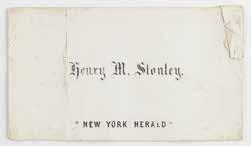
3023. Henry Morton Stanley Group Lot. Group lot related to Henry Morton Stanley and his journey to the African continent in search of explorer David Livingstone, which includes: an ALS signed “Henry M. Stanley,” December 20, 1872, addressed to Captain Josiah Richmond, whose vessel brought Stanley and his men to the Zanzibar coastline in 1871. In part: “I took two white men...with me into Africa. Farquhar died 70 days from the coast...Shaw died on the fourth month from Zanzibar. ‘Omar’ died five days before Farquhar. Indeed for about two months I thought death would sweep us all clean from the face of the earth.” The letter is matted and framed. Includes a pair of opera glasses personally-owned and -used by Stanley, which are accompanied by their original leather case, Stanley’s original New York Herald business card, and a 1939 newspaper article that explains the provenance of the items. In overall very good to fine condition, with scattered light foxing to the letter, creasing to the visiting card, and heavy wear to the opera glasses’ case; the glasses themselves are in fine working order. Starting Bid $300

Impressive 1604 indenture signed by the circulatory system discoverer
3024. William Harvey Document Signed. Distinguished English physician (1578–1657) whose pioneering efforts in the understanding and describing of the human circulatory system take a place among the most epochal advances in the history of science. Though his discoveries were initially greeted with skepticism, Harvey lived long enough to enjoy widespread acceptance of his theories, whose validity he demonstrated through careful experimentation and documentation. The magnitude of Harvey’s contributions to medicine and physiology were such that historian Arthur Schlesinger, Jr. named him one of the ‘Ten Most Influential People of the Second Millennium.’ Extremely rare vellum manuscript DS, signed “Will: Harvey,” one page, 22 x 27.5, November 24, 1604. An indenture between “Thomas Harvey of Folkestone in the County of Kent…Launcelot Browne of London Doctor

of Phisick…and William Harvey Doctor of Phisick,” providing for William Harvey’s wedding gift. In part: “That said Thomas Harvye for and in consideration of a marriage to be had and solemnized betweene the said William Harvye and Elizabeth Browne…and for the naturall love zeale and Affection…and for a competent jointure to be made…covenante and graunte to…the mannor of [Boxstall Lane in Kent].” Signed along the bottom by William Harvey and countersigned by his fatherin-law Lancelot Browne, with two wax seals appended below. In fine condition. Accompanied by a handsome custom-made half morocco case. It is rare to encounter the autographs of the great thinkers of the first half of the seventeenth century such as Shakespeare, Harvey, Milton, Hobbes, Galileo, and Descartes. Starting Bid $5000
Rare document signed by the ‘Father of Modern Taxonomy’

3025. Carl Linnaeus Document Signed. Swedish botanist, physician, and zoologist (1707–1778), who laid the foundations for the modern scheme of binomial nomenclature. Manuscript DS in Swedish, signed “Carl Linnaeus,” one page, 8 x 4, October 10, 1757. Linnaeus acknowledges receipt of his salary as Professor of Medicine and Botany at the Royal Swedish Academy in Uppsala, in part (translated): “From the contact person at the Royal Academy, I have received the missing payments for the third quarter of the current year.” In fine condition. Named the ‘Father of Modern Taxonomy’ and the ‘Prince of Botanists,’ Linnaeus was one of the most renowned scientists and naturalists of his day, having published ‘Systema Naturae’ in 1735, which classified 4,400 animal species and 7,700 plant species. The publication was so important that people from all over the world sent their specimens to be included in subsequent editions, which reached its 12th edition in the second half of the 17th century. Starting Bid $300
Notes for Feynman’s 1975 talk on “New Particles” before student physicists in Vancouver

3026. Richard Feynman Manuscript. Detailed handwritten draft by Richard Feynman, four pages, 8.5 x 11, headed: “Talk at Vancouver, New Particles Etc., Nov. 22, 1975.” Feynman’s draft for a talk given to the Canadian Association of Physics Students on the contemporary state of subatomic particle physics, its current difficulties and possible future developments. Although a ‘popular’ talk, it is pitched at a high level, appropriate to postgraduate students in physics.
On page 1 of this manuscript, Feynman begins with a recap of the situation in particle physics when he gave his talk ‘last year.’ He recalls that hadrons are made of quarks, which come in three ‘colours’; other known particles include the photon, electron, muon, pions. The existence of other particles was hinted at: the W-bosons, and a possible fourth quark. Feynman mentions that the crucial experiment would involve the collision of high-energy electrons and positrons, producing hadrons.
On page 2, Feynman discusses the theories of quarks and the colour force in more detail, and in particular the decay of
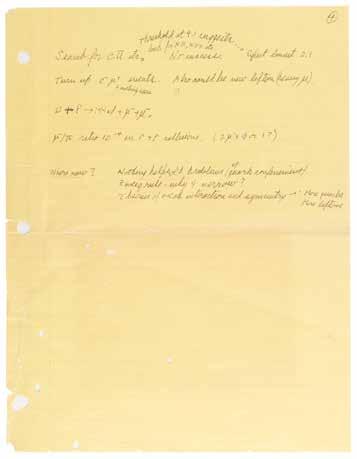
hadrons into other hadrons. He mentions ‘Zweig’s rule’, proposed in the 1960s, which states that when hadrons decay the constituent quarks have to survive.
On page 3, Feynman discusses how the J/ψ -particle decays into hadrons. The J/ψ is composed of a charm quark and a charm antiquark. The Zweig rule means that most modes of decay into hadrons are forbidden. This gives the J/ψ-particle a longer lifetime than would otherwise have been expected, and allows it to decay into photons, which then further decay into hadrons, or into electron-positron or muon-anti-muon pairs.
On page 4, Feynman speculates that there should be a new lepton (‘heavy muon’). He also points out that there is still no explanation of quark confinement, or of Zweig’s rule, and speculates that theories of weak interactions may lead to the existence of yet more new quarks and leptons. In very good to fine condition, with two light diagonal creases, and a central horizontal fold.Starting Bid $2500
3027. Richard Feynman Signed Book. Signed book: Surely You’re Joking, Mr. Feynman!: Adventures of a Curious Character. First edition, first printing. NY: W. W. Norton & Company, 1985. Hardcover with dust jacket, 6 x 8.5, 350 pages. Signed on the first free end page in black felt tip, “Richard Feynman.” Above, in pencil, is the name and address of Edwin M. McMillan (1907-91), winner of the Nobel Prize in Chemistry 1951 for the first artificially-created transuranic element. Feynman and McMillan would have known each other at least since 1942, from when both were working at Los Alamos on the Manhattan Project. Autographic condition: fine. Book condition: spine strip of dust jacket lightly sunned, top 1 mm of cloth spine slightly sunned, vertical crease to front

flap, otherwise both very fine and fresh.
Signed copies of this first printing are rare: Feynman was notorious for refusing to sign copies of his book, reportedly telling his editor ‘I’m not going to go on TV and I’m not going to sign any books!’ (interview with Lawrence Grobel, 28 February, 1986); and although the book eventually sold more than 500,000 copies, its success was unexpected and the initial print run was a lowly 3000 copies. We know of only one other copy of the first printing signed by Feynman to appear at auction (Sotheby’s, New York, 12 December 2017, lot 51, $43,750). Starting Bid $1000
One of the most famous photographs of the 20th Century-Einstein’s Rik=0 equation

3028. Albert Einstein Signed Photograph. Exquisite vintage pearl-finish 8 x 10 photo of Einstein at the blackboard taken by a press photographer at Cal Tech’s Mount Wilson Observatory in Pasadena in 1931, signed in fountain pen, “A. Einstein, 1933.” Einstein had lectured on Unified Field Theory to a small group of scientists at the Observatory, and written on the blackboard is one of the fundamental equations of General Relativity theory: Rik = 0, the equation for a vanishing Ricci Curvature Tensor. In fine condition. “Rik = 0” has been called ‘Einstein’s favorite equation’ and Einstein spent the second half of his life and career attempting to fine tune the precise value of this equation. One of the most significant scientific photographs ever taken—capturing Einstein at a critical moment for his thought: pondering the implications of Hubble’s expanding universe for his own Theory of General Relativity. To our knowledge, this is the only known signed copy of this important image. Starting Bid $5000
Princeton’s resident scholar in 1945

3029. Albert Einstein Signed Photograph. Spectacular vintage matte-finish 8 x 10 photo of Einstein relaxing in his study with his pipe, signed and inscribed in black ink, “Für Dr. Haussner, A. Einstein 45.” Notations penned in another hand on reverse read, “Dr. Albert Einstein, Princeton. Feb. 1945. Photo by Alan W. Richards, Palmer Lab, Princeton, N. J.” In fine condition, with some old adhesive residue on the reverse.
The Palmer Physical Laboratory was finished in 1908 and was originally the Physics Department’s classrooms and offices. Einstein once lectured in this academic hall, which was designed more for utility than for looks. In 2000, Palmer was renamed the Frist Campus Center after it was renovated and enlarged with money from the family of Senator Bill Frist. Alan W. Richards came to work as a photographer at Princeton in the 1940s, and was active through the 1960s. Present at almost every University event, Richards’ photographs in the university archives document the life of the university community. Starting Bid $1000
Einstein offers an algebraic solution to a geometric challenge: “Your little problem has amused me”
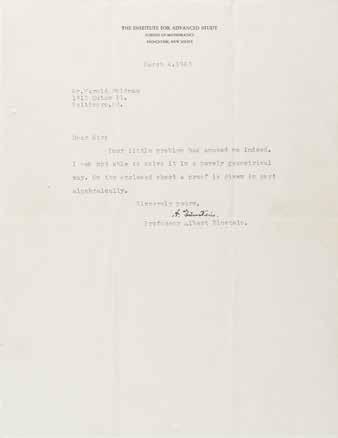
3030. Albert Einstein. Remarkable pairing of items: a TLS signed “A. Einstein,” one page, 8.5 x 11, Institute for Advanced Study, Princeton letterhead, March 4, 1943, responding to Harold Feldman’s request to “Prove that ABC is an isosceles triangle if the lines bisecting the angles B and C and going to the opposite sides are equal,” in full: “Your little problem has amused me indeed. I was not able to solve it in a purely geometrical way. On the enclosed sheet a proof is given in part algebraically.”
On the included sheet, Einstein draws the triangle and marks the angles A, B, and C, the bisecting line m and b, and the bisected halves of the A-C side b´ and b˝. He starts out the proof, “mb22 = c2 = b´2 - 2b´c cos α.” He goes on to prove

the problem presented algebraically, filling the whole sheet with formulas and calculations before concluding: “The fraction being essentially positive it follows c - b = 0.” In fine condition. Accompanied by the original mailing envelope and Feldman’s original handwritten problem on an index card. Originally sold by Robert F. Batchelder in 1991, and accompanied by a letter to Batchelder from a research assistant associated with the publication of the Collected Papers of Albert Einstein, requesting photocopies of the materials.
Handwritten mathematical manuscripts by Einstein are rare— particularly in so complete a form—and, paired with Einstein’s playful letter responding to the challenge, this is a particularly excellent example. tarting Bid $5000
Reporting on life in America, Einstein finds “new and promising avenues” in his scientific work, but fears “significant anti-Semitism in the business world”
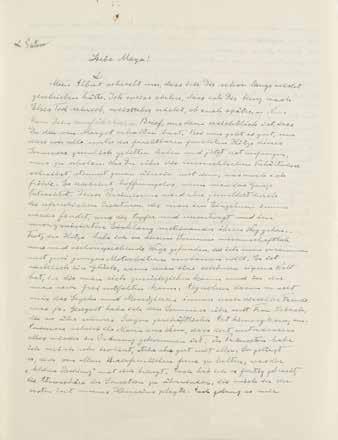
3031. Albert Einstein Autograph Letter Signed. ALS in German, signed “Albert,” one page both sides, 8.5 x 11, no date but circa autumn 1937. Letter to his sister, Maja WintelerEinstein, whom he has not written in some time, reporting on his time and experience in America. A significant letter on topics ranging from science to money and anti-Semitism. After reporting on the “awful humid heat” of the summer, Einstein indicates that he has overcome “the atmosphere of sensation which bothered me in the first period of my time” at Princeton and now lives a somewhat isolated life. He has found “new and promising avenues” in his scientific work, which he is developing together with two collaborators—a reference to his major paper ‘The Gravitational Equations and the Problems of Motion,’ which Einstein wrote with the assistance of Leopold Infeld and Banesh Hoffmann. (During this period Einstein also co-authored with Infeld the popular book The Evolution of Physics).

After mentioning that his oldest son, Hans Albert, is coming to join him in America, Einstein expresses the uncertain hope that his son can find a way to make a living there—both because the times are very difficult (given the Great Depression) and because ”significant anti-Semitism in the business world… also blooms in this free land.” Moreover, Einstein adds: “My fame will not help him, as in truth nothing counts here except money, and my stance on political-social matters is well known and not really popular in the related crises.” In fine condition.
Hans Albert Einstein emigrated from Switzerland to Greenville, South Carolina, in 1938, and found work with the US Department of Agriculture. He later became a professor of hydraulic engineering at the University of California, Berkeley. A fascinating, detail-filled Einstein family letter, touching on both successes and struggles in his newfound home in America. Starting Bid $1000
Extremely rare signed book from Tesla
3033. Nikola Tesla Signed Book. Sought-after signed book: Refractory Materials: Their Manufacture and Uses by A. B. Searle. Second edition (revised throughout and enlarged). London: Charles Griffin & Company, Limited, 1924. Hardcover, 6.5 x 9, 730 pages. Signed and inscribed on the half-title page in black ink, “To B. E. Broadwell, with compliments from, Nikola Tesla, New York, May 18, 1931.” Autographic condition: fine. Book condition: VG/None, with edgewear and rubbing to

boards. The consignor states that he was told this book came from Tesla’s personal library and was gifted to B. E. Broadwell, formerly connected with the Aluminum Company of America, Niagara Falls, N.Y., where he had been engaged as general superintendent. Bartley E. Broadwell filed for US Patent on his Electrode in 1930, granted on October 4, 1932. Tesla had famously consulted on the hydroelectric power plant built at Niagara Falls at the turn of the century. Starting Bid $2500
Collection of Nobel’s autograph letters, drawings, and documents about his dynamite factory in Italy

3034. Alfred Nobel Autograph Letter Signed and Dynamite Factory Document Collection. Extraordinary collection of autograph letters, plans and documents, and drawings of machinery and buildings regarding Alfred Nobel’s establishment of a dynamite factory near Turin, Italy in 1872-1873. ALS in French, signed “A. Nobel,” three pages on two adjoining sheets, 8.5 x 10.5, September 6, 1872. Written from Paris, a letter to Paul Barbe, in which Nobel gives his detailed requirements for establishing the Italian factory to produce dynamite at Avigliana (near Turin), under the aegis of his agent of Casimir Robaudi. He proceeds to explain his requirements in a detailed table predicting the production and sale of the dynamite and outlining the terms of the contract. Nobel’s specifications include the measurements of the brick

buildings, power of the traction engines, nitrite grinders, and other machinery; a building to house nitric acid, an ice room, various other buildings in wood for the production and washing of glycerine and dynamite. He outlines the five-year contract with Robaudi for which he can set a price above market rates. If the company does not receive payment for the dynamite, Nobel advises Barbe to revise the contract before sending it to Carstens, the merchant in Hamburg. Third page features pencil annotations, one marking the extension of the contract to six years. The balance of the collection, (the majority written in the Italian language), includes an assortment of 15 plans, sketches, legal and technical manuscripts, and other related documents that amount to over 100 pages. In overall very good to fine condition. Starting Bid $2500
Excessively rare portrait signed by both Wilbur and Orville

3035. Wright Brothers Signed Photograph. Exceptionally rare 3.5 x 5.5 real photo postcard of the Wright brothers standing side by side, boldly signed in the lower border in ink, “Orville Wright” and “Wilbur Wright.” Reverse bears an ANS in French by Rene Pellier, the vice-president of the Aero Club of Sarthe, dated May 1, 1909, in full (translated): “10:30 PM-We just offered, the bronze for which you have contributed, to the Wright brothers, and I make haste to send you this card signed by them.” In fine condition, with minor creasing and silvering to upper left corner, and a French postage stamp affixed to upper right. At an honorary banquet in Le Mans on May 1, 1909, Leon Bollee presented the Wright Brothers with an impressive bronze trophy symbolizing the Muse of Aviation on behalf of the Aero Club of Sarthe. This reception must have been where the famed brothers signed this postcard. An exceedingly rare example, this is the only signed portrait showing them together that we have encountered. Starting Bid $1000
Signed on the day Wilbur set the world aviation altitude record

3036. Wilbur Wright Signed Photograph. Outstanding French postcard from the series ‘L’Aviation en 1908,’ 5.5 x 3.5, reproducing the photograph by J. Bouveret of the Wright flyer at the Camp d’Auvours in Le Mans, France, signed in the lower right in fountain pen, “18 December 1908, Wilbur Wright.” In fine condition. On December 18, 1908, Wright flew his plane to an altitude of 115 meters (approximately 360 feet) and set a new altitude record. A few weeks later, on December 31st, he won the Michelin Prize of 20,000 francs for the longest flight of the year, which departed from Camp d’Auvours and lasted 2 hours, 18 minutes, and 53 seconds. At the time Wilbur signed this postcard, Orville was still recovering from the disastrous crash at Fort Myer, Virginia, on September 17, which had resulted in the death of his passenger, Lt. Thomas Selfridge—the first airplane fatality. Starting Bid $1000
The Wright Brothers prepare to demonstrate the “genuine value of our discoveries... by a flight of one of our machines”

3037. Orville Wright Typed Letter Signed. Partial TLS signed for both by Orville, “Wilbur & Orville Wright, O. W.,” one page, 8.5 x 11, Wright Cycle Company letterhead, [November 4, 1905]. The concluding page of a two-page letter to Captain Ferdinand Ferber, in part: “Under the present circumstances we would consent to reduce our price to the French government to one million francs...The price would include a complete machine, instruction in our discoveries relating to the scientific principles of the art, formulas for the designing of machines of other sizes, speeds, etc; and personal instruction of operators in the use of the machine.” Includes the unsigned first page of a letter from the Wrights to Ferber from one month earlier, dated October 9, 1905, which also contains exceptional aviation content. In overall very good to fine condition, with light creasing, intersecting folds, and loss to the lower right corner of the first page. Starting Bid $1000
Carried to the summit of the Hadley Delta by CDR Scott on Apollo 15

3039. Apollo 15 Lunar Surface Flown Flag. Outstanding flown American flag, 5.75 x 3.75, carried to the lunar surface aboard the Lunar Module Falcon during the Apollo 15 mission and stowed in the pocket of Commander Dave Scott’s space suit during all three lunar surface EVAs. The flag is signed and flight-certified in blue ink, “Carried in my suit during all three EVAs, Dave Scott, Apollo 15 CDR”; it is also marked with a lowercase Greek delta symbol (“?”) on the reverse, signifying its ascent of the Mons Hadley Delta. Includes a glossy 10 x 8 photograph of Scott standing in front of the LRV, annotated and signed in black felt tip, “Your flag was carried here!! Dave Scott, Apollo 15 CDR,” with his pocket circled. Also accompanied by a photo of Dave Scott holding the flag, and a signed letter of provenance. In very fine condition. A choice surface-flown artifact boasting excellent provenance from one of the Apollo program’s twelve moonwalkers. Starting Bid $2500

3040. Howard Hughes Autograph Letter
Signed. ALS signed “Howard,” four pages, 8.5 x 13.25, June 1, no year. Letter to his assistant, confidant, and former FBI agent, Robert “Bob” Maheu, in part: “I am delighted with the prospect of this project. Please take it over and make an all–out effort to accomplish the desired result in the very minimum time. Bob, this is a ten-strike...I am pressing you with all possible urgency to make some kind of a deal...As you may guess, I want another channel here like I want a dozen more hotels.” In fine condition, with staple holes to the upper left corner. Starting Bid $200
“If Sonnett finds out we are surveilling him it would be the end of everything”—cloak-anddagger content from the TWA v. Hughes lawsuit
3041. Howard Hughes Handwritten Notes. Intriguing unsigned handwritten notes by Howard Hughes, one page both sides, 8.5 x 14, November 13, 1965. The uppermost portion is written in a secretarial hand, “From Maheu,” referring to ex-FBI and CIA operative Robert H. Maheu, who acted on behalf of Howard Hughes to thwart blackmailers, spy on enemies and ingenues, and conduct other covert business. Below, Hughes jots his notes on the matter, in part: “We lose trading positions in the biggest business deal in history of industry in U.S. and the world...Please tell Mayheu I am not trying to blame anyone for anything, but I thought Mayheu understood everything in this message. If Sonnett finds out we are surveilling him it would be the end of everything.” In fine condition. These fascinating notes evidently reveal that Hughes was having John Sonnett, counsel for Trans World Airways, tailed and surveilled. In 1962, Sonnett had filed a complaint on behalf of TWA, charging Hughes with violating antitrust laws. Starting Bid $200
Unique signed portrait of Freud by a fellow Viennese artist

3042. Sigmund Freud Signed Drawing. Unique circa 1929 hand-drawn portrait of Sigmund Freud accomplished by Henry Major in charcoal on an off-white 8.5 x 10.25 sheet, prominently signed below in pencil by the subject, “Sigm. Freud,” and by the artist, “Major.” In fine condition. Born in Hungary in 1889, Henry Major worked as a caricaturist in Vienna and London before moving to the United States; he likely sketched Freud in Vienna, where the pioneering psychoanalyst lived and worked from 1886 to 1938. Though Freud signed multiple photographs of himself, signed hand-drawn portraits of him are very rare. A desirable and significant image of Freud with an uncommon signature incorporating his first name. Starting Bid $500
The 24-year-old “Fritz Nietzsche” writes to his childhood pal upon taking a professorship in Basel: “You learn to neglect your most sacred duties, friendship”

3043. Friedrich Nietzsche Autograph Letter Signed. Extremely rare ALS in German, signed “Fritz Nietzsche,” three pages on two adjoining sheets, 5.25 x 8.25, July 4, 1869. Letter to his childhood friend Wilhelm Pinder, in part (translated): “The first sign of life that you receive from me from Basel is a birthday letter. You can see the demoralizing influence of such an office: you learn to neglect your most sacred duties, friendship. Today, however, when a look at the calendar made it clear to me the injustice I had committed, I was urged to ask you for absolution...I should think that after the storms
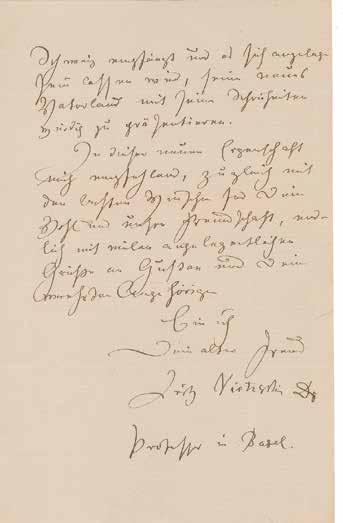
and excitement of your profession, you should often have a longing to have a rest in an alpine valley away from murderers and other rascals...You always have to tell me such plans first, because I am now for all my friends the Alpine Guide, who will receive them at the Swiss border and who will be happy to present this new fatherland with its beauties.” In fine condition. Accompanied by the original mailing envelope, addressed in Nietzsche’s hand and bearing his complete monogrammed wax seal (“F. N.”) on the reverse. Starting Bid $5000
Gifted to his mistress, a rare sketch from Modigliani’s ‘Caryatid’ series
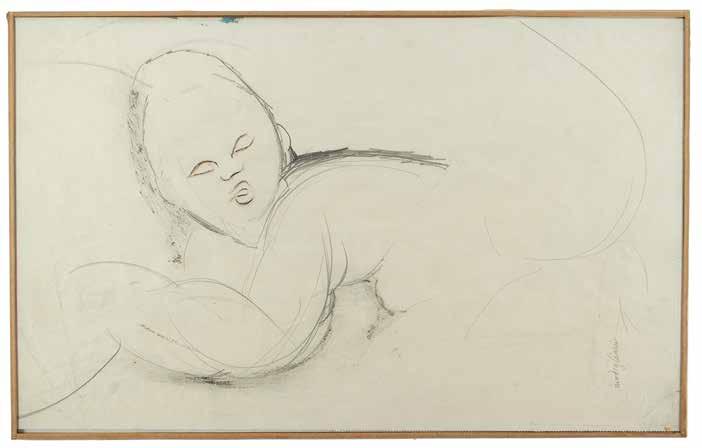
3044. Amedeo Modigliani Original Sketch. Superb original sketch by Italian Jewish painter and sculptor Amedeo Modigliani entitled ‘Cariatide’ (1913), accomplished in graphite on an off-white 16.75 x 10.5 sheet, which is signed vertically in the lower right, “Modigliani,” and inscribed on the reverse, “a Madame Hastings.” An example from his ‘Caryatid’ series, the sketch depicts a human figure, either a child or a woman, with head turned towards the observer. Framed to a slightly larger size and in fine condition.
From 1909 until 1914–15, Modigliani made more than seventy sketches of Caryatids, which he originally conceived as preparatory drawings for an ambitious sculpture project that he called ‘colonnes de tendresse’ (columns of tenderness). The Caryatids—stylized representations of women that functioned as columns or pilasters in an architectural setting—were notably influenced by African art, which is evident in the poses of the figures and their mask-like faces. These Caryatid sculptures were planned for a secular temple devoted to the beauty of humankind. The recipient of this drawing was Beatrice Hastings, an English writer, poet and literary critic, who shared an apartment in Montparnasse with Modigliani and became his model for countless paintings, including the 1916 work, ‘Seated Nude.’
Provenance: Collection of Monsieur F. (auction at Hôtel Drouot, 22nd November 1922, lot no. 14) Collection of Monsieur Coste, by descent. Starting Bid $5000
The final letter from Cézanne, written three days before his death

3045. Paul Cézanne Autograph Letter Signed with Original Sketches. Extraordinary ALS in French from Paul Cezanne, written on October 19, 1906, just three days before his death at the age of 67, one page, 5.5 x 8.75, which boasts a pair of boldly penned original ink sketches to the top and bottom portions; the upper sketch appears to be a self-portrait in profile, and the lower, which bears a resemblance to that of his unfinished work ‘Les Grandes Baigneuses,’ or ‘The Bathers,’ seems to show leaning branches or fencing through which the observer can detect a small structure in the distance.
The letter, written from Aix and addressed to a color merchant, contains a request for 10 of some variety of lacquer (translated), “I have not yet received a response. What is going on? Sending you, sir, my regards.” In very good condition, with intersecting folds and scattered staining and soiling. On October 15th, Cézanne was caught in a downpour while working in a field between the Chemin des Lauves and the rugged Mont Sainte-Victoire Range. He continued undeterred for two hours before opting to return home, eventually collapsing on a country road and being discovered by a passing cart. The two riders, who identified the unconscious man as Cézanne, quickly delivered him into the care of his housekeeper, Madame Bremond. Upon awakening, Cézanne, eager to complete his rain-delayed work, purportedly inquired if the sun had resumed shining. Stricken with pneumonia, he attempted to paint the following day, but fainted in the process and was placed in bed, the location from which this letter was ostensibly written. A somber note from the fading artist, and very possibly the last letter to come from the hand of Cézanne. Starting Bid $5000
Dali’s last sitting with Halsman in 1978

3046. Salvador Dali ‘Last Sitting’ Photograph by
Philippe Halsman. Rare original color 8 x 9.75 photograph of Salvador Dali taken by Philippe Halsman in 1978, affixed to its original 9 x 11 mount, marked “Halsman” and “N.Y. 1978.” Impressively matted and framed to an overall size of 19.25 x 23.25. On the reverse is a Volunteer Service Photographers exhibition/auction slip filled out in ink by Halsman with his name, contact information, and the piece’s size and title: “Philippe Halsman, 33 W. 67 N.Y.C. N.Y. 10023, (212) 362-9670, Salvador Dali 1978, 9 1/2 x 8.” In fine condition, with slight fading to the image. This portrait was sold at auction on December 7, 1978, to benefit Volunteer Service Photographers, Inc., an organization that taught photography to veterans. Starting Bid $500
Exquisite original ‘heart’ sketch from Belgian’s Surrealist master—‘Dessin pour Le sac à malice’

3047. René Magritte Original Artwork. Original artwork by Belgian artist René Magritte from 1964 entitled ‘Dessin pour Le sac à malice’ (‘Drawing for The Bag of Tricks’), accomplished in black ink on an off-white 8.75 x 12 sheet of artist paper and signed in the upper left corner, “Magritte.” Based on his own 1959 gouache painting, ‘Le sac à malice,’ the drawing depicts a large human heart set upon a short base—as if a trophy— with the open air background scattered with the movement of clouds and wind. Attractively matted and framed to an overall size of 18.25 x 21.75. In fine condition.
The heart-shaped object, perhaps made of stone like its predecessor, is not unlike other ‘balusters’ or ‘bilboquets’ found in the works of Magritte, whose adoration for the game of chess can likewise be discerned by the object’s shape. Magritte, himself an avid chess player and habitué at the popular Greenwich Tavern in Brussels, incorporated the game and its pieces in several of his paintings, such as ‘Nocturne’ and ‘The Two Sisters’ (1925), ‘The Difficult Crossing’ (1926), and ‘Fashionable People’ (1950). Fellow surrealist Max Ernst identified these peculiar pieces as ‘phallustrades,’ a name indicative of their sexual allusion. An immensely appealing original sketch from the Surrealist master, and a work redolent of his ‘petrification’ period of turning live objects into stone.
Provenance: Sotheby’s, Property from the Collection of JeanYves Mock, February 2005. Accompanied by a certificate of authenticity from the Comité René Magritte, certifying it as an original work by Magritte. Starting Bid $10000
Scarce 1985 UNICEF poster celebrating NYC’s underground art scene, signed by Haring, Warhol, Lichtenstein, Basquiat, and Ono

3048. Haring, Warhol, Lichtenstein, Basquiat, and
Ono Signed ‘Rain Dance’ Poster. Exceptional color 22 x 31 offset lithograph poster entitled ‘Rain Dance: A Benefit for the African Emergency Relief Fund’ in 1985, signed in felt tip by the five collaborating artists: Jean-Michel Basquiat, Keith Haring, Andy Warhol, Roy Lichtenstein, and Yoko Ono. In fine condition.
Published by UNICEF to advertise a fundraising exhibition and party to combat hunger in Africa, this poster is considered a classic of 1980s pop art. From Andy Warhol: The Complete Commissioned Posters, 1964-1987, by Paul Marechal (p. 116): ‘This poster reflects the créme de la créme of New York’s artistic and social circles in 1985. Water, so essential to combat drought and famine prevailing in Ethiopia, was the poster’s principal message and its theme, rain, is treated from different perspectives b y each of the artists: graphic (Lichtenstein’s oblique lines), practical (Warhol’s umbrellas), ethnographic (the rain dance by Haring), political (Basquiat, combining the homophones rain and reign, and geographic (Ono, whose footsteps illustrate Africans’ long walks to reach rare water sources). Given its rarity on the market, one can estimate that some one thousand posters were printed, of which 100 were signed by all five artists, while a few others were signed by only one or a few of them.’ Starting Bid $1000
“Admonish” as defined by Noah Webster for his American Dictionary of the English Language
3049. Noah Webster Manuscript. Rare handwritten manuscript from a draft of An American Dictionary of the English Language, unsigned, one page, 7.75 x 9.75, no date but circa 1824-1825. Definitions from the ‘A’ section of Webster’s dictionary, consisting entirely of definitions for “Admonish” and its several forms. After tracing the etymological origin of “Admonish” in a section that has been struck through, Webster defines the word: “To warn or notify of a fault; to reprove with mildness. ‘Count him not as an enemy, but admonish him as a brother.’ 2 Thess 3.15.” He goes on to define “Admonished,” “Admonisher,” “Admonishing,” “Admonition,” “Admonitor,” and “Admonitory,” while noting “Admonishment” as “Obsolete— Shakespeare.” In very good to fine condition, with splitting to a horizontal fold, and paper loss along the left edge. Accom
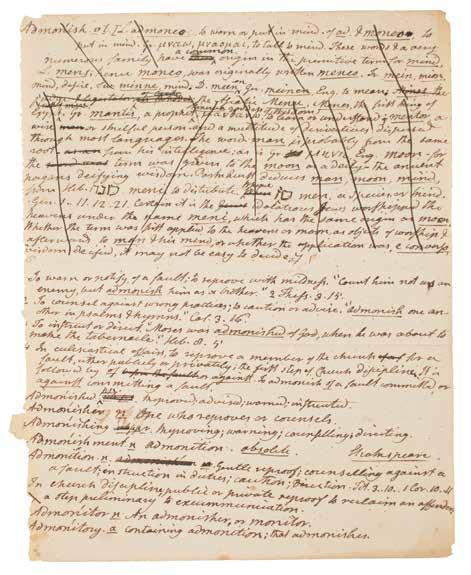
panied by the printed leaf from Webster’s Dictionary on which “Admonish” is defined, and an engraved portrait of Webster.
The bulk of Webster’s manuscript—over 450 leaves—now resides in the Pierpont Morgan Library, and complete leaves rarely appear for sale. Webster’s dictionary is the cornerstone of the brand of English spoken in America today, and this manuscript offers fabulous insight into Webster’s discerning and comprehensive editorial process as he compiled the foundational text. This definition from Webster’s draft differs substantially from the text as published, where it received a significantly reduced etymological analysis. A fascinating piece of linguistic history. Starting Bid $1000
Beautifully penned 1846 handwritten letter from “Edgar A. Poe”
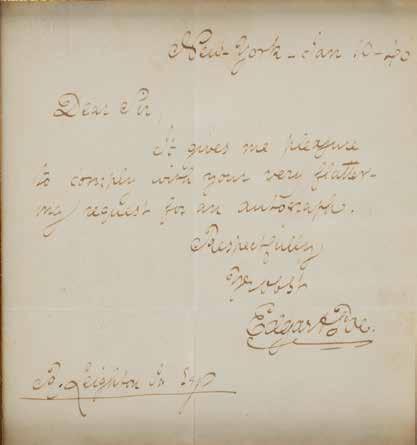

3050. Edgar Allan Poe Autograph Letter Signed. Rare ALS signed “Edgar A. Poe,” one page, 4 x 4.25, January 10, 1846. Written from New York, a brief letter to collector “R. Leighton, Jr. Esq.,” in full: “Dear Sir, It gives me pleasure to comply with your very flattering request for an autograph. Respectfully, Yr ob st.” Archivally matted and framed with an engraved portrait and a passage from Poe’s classic The Raven to an overall size of 18.75 x 33.5. In fine condition.
Following the demise of his short-lived newspaper the Broadway Journal, Poe, with his wife Virginia Clemm and her mother Maria, around May 1846, departed Turtle Bay and moved into a cottage on two acres of land in Fordham, New York. The rural setting and the cottage’s quaint charms appealed to the family greatly, and Poe’s final short story, ‘Landor’s Cottage,’ published not long before his passing in 1849, is presumed to have been inspired by the home. It was also where Poe wrote the classic tale The Cask of Amontillado, the poems ‘The Bells,’ ‘Annabel Lee’ and ‘Ulalume,’ and where he published his gossip series on ‘The Literati of New York City.’ Only our sixth handwritten Poe letter, and our first in five years. Starting Bid $5000
The Women’s World editor coaches a contributor on the writing craft


3051. Oscar Wilde Autograph Letter Signed. ALS, four pages on two adjoining sheets, 4.5 x 7, personal letterhead, no date but circa late 1880s. Letter to Mrs. Pfeiffer, written while Wilde was editor of the magazine The Woman’s World, in full: “With a different beginning the Rossetti article will do very well. What excellent prose you write! So full of colour and feeling, yet so self-restrained. It is not poetical prose, it is the prose of a poet. What would you think of taking as a ‘peg’ for the article the drinking fount just erected in front of Rosetti’s house, and unveiled by Holman Hunt. Are there ‘living waters’ in Rossetti’s poetry? Do men thirst again when they drink of it? This is merely a suggestion. Thank you very much for the article.” In very good to fine condition, with scattered light foxing, and a stain to the lower blank area of the last page. Wilde was editor of The Woman’s World from November 1887 to July 1889, during which time he transformed the magazine from a lady’s fashion publication to a bastion of cultural importance, with articles on literature, culture, the arts, society, and politics. Journalism was an industry dominated by men, and Wilde’s magazine recognized the thoughts and opinions of men and women as equal, doing much good for the early feminist cause. Still, Wilde exercised control over the publication as demonstrated in this letter, which displays his editorial manner and style—one of flattery and gentle coercion—in dealing with potential contributors. An extremely desirable letter by the sought-after writer, enhanced by its fine artistic associations and his personal commentary on literary technique. Starting Bid $500

3052. Kahlil Gibran Autograph Letter Signed. LebaneseAmerican artist and writer (1883-1931) best known for his writings on religion and for his best-selling 1923 spiritualphilosophical classic The Prophet. ALS, one page, 6.25 x 8.25, no date but circa 1916. Letter to James Oppenheim, author and editor of the short-lived Seven Arts magazine, in full: “This war poem came to the Seven Arts through me. It might interest you to read it. I have been wrestling with an angel and a devil during the past two months. And it is indeed terrible to be between two powers so different. In a week or so I shall leave town for a much needed rest in the country. May I not see you before I go?” In very good to fine condition, light toning and some old tape stains along the edges. The Seven Arts was founded with the idealistic goal of transforming American life through the arts, featuring contributors such as Dreiser, Frost, Mencken, and Dos Passos, but folded in 1917 after just one year. In 1916, Gibran was preoccupied with the war in his native Syria, actively soliciting funds and suffering emotional distress at any war news; although he diverted his energy toward writing, the predominant theme from this period was death. In September he left New York to visit his sister on Cape Cod hoping to relieve this building stress, but suffered a nervous breakdown. A remarkable letter from a tumultuous period of Gibran’s life that influenced his writing for years to come. Starting Bid $200
Rare mention of Fitzgerald’s greatest work “Thanks for your letter about Gatsby”
3053. F. Scott Fitzgerald. Rare and significant ALS, one page, 8 x 10.5, no date [circa 1925-1926]. Fitzgerald writes from Paris to literary agent and editor William C. Lengel regarding plans for a stage adaptation of the Great Gatsby. In full: “Thanks for your letter about Gatsby. Have just had a wire from Brady asking for dramatic rights and wired my agent asking him to see what Brady’s plans are—all this before your letter came, as it went to Cannes & Homer Croy whom I’ve never met. As soon as I get any word I will let you know. Perhaps he has no one in mind for the dramatization & in that case it would much better [sic] if it were done by someone like you who already has some plan in his head. With many thanks.” After signing, Fitzgerald adds a postscript and signs again with his initials: “Word has just come that Owen Davis is going to do it for Brady. Thanks many times for your interest. F.

S. F.” In fine condition, with a professionally repaired tear to the left margin.
Fitzgerald’s most famous novel, widely regarded as one of the finest in the English language, was published in spring 1925 to a rather unremarkable reception. Still, with the public’s everincreasing appetite for entertainment, newly published fiction provided an instant source of material for the stage and screen. With its dramatic force and colorful characterizations, it was only a matter of time before Gatsby would attract attention in showbiz circles, and it first made the jump from page to stage in a semi-successful adaptation by dramatist Owen Davis that ran for 112 performances in 1926. Starting Bid $2500

3054. J. R. R. Tolkien Typed Letter Signed. TLS, one page, 8 x 10, July 3, 1961. Letter to C. Gilmore, explaining that he will write no sequel to Lord of the Rings, making the further crucial point that, in his view, the pure story-telling possibilities of the The Lord of the Rings trilogy are exhausted. Concluding, however, he alludes to writing a prequel to The Lord of the Rings—presumably The Silmarillion.
In part: “No story has any end. No picture has any boundary. But one has to put one’s small vision into a frame, because you cannot see anything clearly unless you concentrate on it. I shall not write a sequel to The Lord of the Rings because, as is really clearly stated in the course of the story, it is the end of the kind of world about which I write: the twilight in which mythology and history are blended. After that there is only history. But I am supposed to be writing a sequel (in the sense that it will be published after The Lord of the Rings), though the stories will be about the time before, in the First and Second Ages.” In fine condition. Accompanied by the original mailing envelope.
Tolkien in fact toiled greatly over the question of how to end The Lord of Rings—he reportedly wrote some five different endings for it—and this letter sheds significant light on the philosophy of writing which guided his ultimate decision. Starting Bid $2500
Beethoven sends his ‘Missa Solemnis’ to London

ALS in German, signed “Beethoven,” one page, 9.5 x 8.25, circa September 1823. Letter to Franz Christian Kirchhoffer, concerning the sending of the ‘Missa Solemnis’ to London. He invites him to lunch at his flat on Sunday, with his nephew Karl: the weather appears promising, and his presence would be a great pleasure for both of them. In full (translated): “My dear Kirchhoffer: If it is not possible to send a packet through the English embassy to London, please inquire. I will therefore tomorrow send an answer or if you think it is good for the occasion? On Sunday we will certainly see you, my Karl and I at table, the weather seems to be favorable again and it will be very pleasant for us both to have you here.” In very good condition, with professional repairs and restoration, including full backing. Accompanied by an export certificate from the French Ministry of Culture. Kirchhoffer served as cashier at the Hofmann & Goldstein Bank in Vienna. Several times in 1823 he helped Beethoven to send funds as well as music to their mutual friend Ferdinand Ries in London. The shipment of the “packet” in question is the just-completed Missa Solemnis, op. 123, for which Ries is to find a publisher. During Beethoven’s lifetime, the Missa Solemnis was widely considered his masterpiece. It was this work to which he dedicated the most time and intense effort, working on it over the course of four years. In a letter of 1819, Beethoven wrote, ‘The day when a High Mass of mine is performed in honor of the solemnities...will be the most delightful of my life,’ and in 1822 called the Missa Solemnis his ‘greatest work.’ The piece is even present in the most famous image of Beethoven, an 1820 portrait by Joseph Karl Stieler, which shows the composer holding a pencil above his notebook labeled ‘Missa Solemnis.’ A superb autograph letter by the revered composer. Starting Bid $10000
Tchaikovsky writes to the son of anold friend from the Moscow Conservatory

3056. Pyotr llyich Tchaikovsky. Rare and desirable ALS in French, signed “P. Tchaikovsky,” one page, 4.5 x 5.75, February 25, 1889. Letter to “Mon cher ami Paul,” [‘My dear friend Paul,’ most likely Paul Cossmann, German writer and director of the magazine Süddeutsche Monatshefte and a longtime friend of Tchaikovsky’s]. In full: “I beg you to excuse me. I will not be able to have the pleasure of having lunch with you today. I was wrong not to have taken your address the other day. This prevented me to advise you in time. This morning I have a rehearsal after which I absolutely need to have lunch with the Russian Consul. Please come tomorrow to my house at one in the afternoon. Pray excuse me.” In fine condition.
While in Frankfurt in February of 1889, the second stop on his itinerary through Germany, Tchaikovsky had the fortune of meeting with his old friend Bernhard Cossmann, a German cellist and former colleague at the Moscow Conservatory. Two days later, after Tchaikovsky’s hugely successful performance of his Suite No. 3, the Cossmanns saw him off at the railway station, asking the composer to get in touch with their son when he arrived in Berlin. Accepting their suggestion, he dashed off this letter to the young Paul Cossman, with whom he ended up meeting two days later. Cossman would go on to make quite a name for himself, founding the liberal cultural magazine Süddeutsche Monatshefte before losing his life in a concentration camp during World War II. A rare letter from the highly sought-after musical legend, written at the height of his fame. Starting Bid $1000
“Strange Fruit”—the final song on Billie Holiday’s handwritten setlist
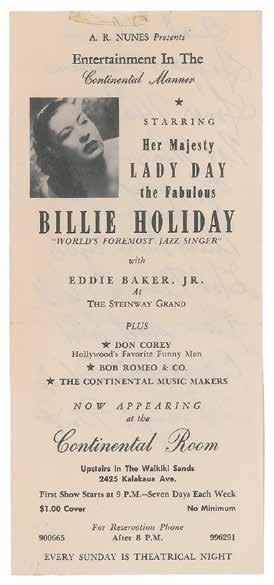

3057. Billie Holiday Handwritten Setlist. Significant handwritten setlist by Billie Holiday, penned on the reverse of a 4 x 9 handbill for her shows at the Continental Room in Waikiki, Honolulu, Hawaii, no date but circa 1950. Writing in blue ballpoint, Holiday lists the songs from her “2nd Show,” in full: “Jeppers Creppers, Jones Man, Too Marvelous, Porgey, Them There Eyes, God Bless the Child, Please Don’t Talk, Come Rain Shine, Strange Fruit.” In fine condition, with a central horizontal fold, and an old tape stain at the top edge.
Written as a charged protest song against the horrifying lynching of black people in the South, “Strange Fruit” was recorded by Billie Holiday in 1939 and became a staple of her performances at the Cafe Society, New York City’s first integrated nightclub. To recognize and emphasize the song’s power, club owner Barney Josephson drew up some rules for its performance: Holiday would close with it; the waiters would stop all service in advance; the room would be in darkness except for a spotlight on Holiday’s face; and there would be no encore. Thus, it became the ritual, dramatic, melancholic close to her act—not just a song, but a socio-political declaration that reverberated through the night. This setlist written in Holiday’s hand, fittingly naming her iconic song at the end her performance, is a moving and historically important piece. Starting Bid $500
The never-before-seen biography of Lead Belly


3058. Huddie ‘Lead Belly’ Ledbetter Manuscript
Collection. Unprecedented collection of typescript and manuscript notes for an unpublished biography of Huddie ‘Lead Belly’ Ledbetter, originally recorded and compiled by his management team of Marjorie Fairbanks and her son Austin C. Fairbanks. The partial biography consists of eighteen sheets, ranging in size from 8.5 x 2.25 to 8.5 x 11, with some sheets featuring additional text to reverse, others arranged with affixed paragraph slips, and all bearing extensive pencil corrections and emendations. The notes concern the decade-long friendship between Ledbetter and Austin Fairbanks, and cover a wide range of topics that include Ledbetter’s early years, the origins of his musical talent, his relationship with folklorists John and Alan Lomax, and his seven-month incarceration after a Manhattan stabbing in 1939. One segment references songwriter Woody Guthrie, whom Ledbetter befriended during his time in New York City, in part (spelling and grammar retained): “I was going to ask somthing that perhaps is not important but the general commentary or mr woodie guthrie when he writes about leadbelly is that he sings with a force to be compared with the force with which a prisoner sings after he is released from concentration camps.” Another relates to Ledbetter’s release from Imperial Farm prison: “After his prison sentence in 1917 he served seven years until 1925 he went back to lethe who had apparently picked up with another man and his song dont you love your daddy may very well reflect his feelings in that he had always kaken care of her while he was with her and while he wqs in prison through no fault of his own and when he came back she wasn’t half as enthusiastic about him.” A later passage refers to the 1939 attack in Manhattan: “He gave a recital in new york and two friends who had walked to it with him tried to hold him up as he was returning home with the money that he had collected. He had the money in a paper bag when they tried to hold him up at his apartment door. They attacked him with a knife trying to do a regular mugging and threatening to cut his throat. He took the knife away from that man and beat him into a pulp, cutting the other one pretty abdly, leaving him to ran away.” Includes the original folder. In very good to fine condition, with general toning and occasional chipping to the edges of some papers. Many of the details found within the typescript notes have yet to be published, making this a tremendously important research archive for the legendary blues musician. Starting Bid $1000
Early Peter Kaye promo portrait, signed in-person by the Beatles at the Savoy Ballroom in April 1963

3059. Beatles. Remarkable vintage 8.5 x 7.5 paperstock photo of the Beatles excised from an early sheet music book, signed at at the Savoy Ballroom in April 1963 in blue ballpoint, “John Lennon,” “All the best, Paul McCartney,” “Best wishes from George Harrison,” and “Ringo Starr, xxx.” This rare image was captured by photographer Peter Kaye in a promo shoot shortly after Ringo joined the band in 1962, and was subsequently published in a 1963 songbook; affixed to the reverse is a partial page of sheet music for ‘Please Please Me,’ their early hit single recorded in January 1963. In very good to fine condition, with trimmed edges and faint rippling. Accompanied by a letter of authenticity from noted Beatles expert Frank Caiazzo, in part: “This photo was signed by The Beatles on April 7, 1963, when they were performing at the Savoy Ballroom, Portsmouth, Hampshire, England. This is an extremely rare signed early image, and very few have surfaced to date.” Also accompanied by an original newspaper clipping advertising the Beatles (as the “Star Attraction!!”) and supporting act Mike Devon & the Diplomats at the Savoy Ballroom on April 7, 1963, as well as an original vintage glossy 9.75 x 7.75 photo of Mike Devon & the Diplomats on stage. As a well-documented early, rarely seen promo portrait boasting large and bold in-person signatures by the Beatles, this is a truly fabulous piece. Starting Bid $1000
Fantastically early Cavern Club membership signed by John, Paul, George, and Best, with the latter signing 16 times!
3060. Beatles. Exceedingly rare Cavern Club membership card booklet for 1961, measures 4.75 x 4 open, signed inside in blue ballpoint, “John Lennon,” who signs below in black ink, “again, John Lennon,” in black ink, “Paul McCartney,” who signs again below, “Paul McCartney (once again),” “George Harrison (for the last time),” and “Pete Best,” who signs the adjacent page in pencil 12 times. Additionally, Best adds his signature twice to the preceding “Riverboat Shuffle, Dates” page and then once more to the inside back cover, which amounts to a total of 16 Pete best autographs! The booklet, issued as No. 2862, features the owner’s name penned on the inside front cover. In very good to fine condition, with light wear and staining, and the inner pages detached. Accompanied by a certificate of authenticity from Tracks and by a typed letter of provenance (Read exceprt from letter online).Starting Bid $1000
Exceedingly rare 1965 poster for the Beatles at Shea Stadium

3061. Beatles Shea Stadium Poster. Fantastic original 11 x 17 concert poster for the Beatles’ historic concert at Shea Stadium on August 15, 1965, with the billing containing other New York area shows featuring artists like Herman’s Hermits, the Dave Clark 5, The Kinks and Moody Blues, Phil Ochs, Chuck Berry, and Johnny Cash. The simple poster is printed with bold black lettering on heavyweight cardstock. In very good to fine condition, with light spotting and dampstaining to the upper right. Designed as generic ‘throwaway’ posters, these are extremely rare today. The legendary Beatles show at Shea Stadium went on to break records for attendance and revenue, and today is still considered one of the greatest concerts of all time. Starting Bid $300
Rare oversized sketch of Lennon and Ono

3063. Beatles: John Lennon. Remarkable original selfportrait sketch by John Lennon on an off-white 11 x 8.5 sheet, which depicts Lennon and his wife Yoko Ono, with both signing in the lower right, “John Lennon, 1969” and “Yoko Ono Lennon.” In fine condition, with a crease and two small edge tears at the bottom, and small stains in the corners, all easily matted out. Accompanied by a letter of authenticity from noted Beatles expert Frank Caiazzo. A hugely desirable oversized sketch that dates to the year Lennon left the Beatles and formed the Plastic Ono Band. Starting Bid $1000
Historic 1969 Lennon deposition concerning ‘Come Together’ and Chuck Berry plagiarism


3064. John Lennon Document Signed. DS, seven pages, 8 x 10.5, April 13, 1971. Deposition of John Lennon in the plagiarism lawsuit made by Big Seven Music Corporation against Maclen Music, Inc., Northern Songs, Ltd. and Apple Records, Inc. The document contains an examination made by counsel M. William Krasilovsky, in which he questions whether Lennon acknowledges himself as “the sole writer of the song Come Together as recorded by the Beatles on the LP album entitled Abbey Road” and whether he acknowledges his familiarity “with the works of Chuck Berry and specifically the musical composition You Can’t Catch Me as recorded by Chuck Berry…and by the Rolling Stones.” Lennon answers “Yes” to both questions, and affirms that “ever since I was in my teens I was acquainted with the works of Chuck Berry whom I consider one of the original rock and roll poets. I heard his recording of You Can’t Catch Me at this time and spent many hours in generally [sic] listening to his general catalog.” Signed at the conclusion in black felt tip by Lennon, and countersigned by a commissioner for oaths. Includes an annexed certificate for the admittance of Joseph Herbert Bueno de Mesquita, the aforesaid commissioner for oaths. Also included are various comparison music charts for the two songs, copies of music sheets, and a copy of Lennon’s settlement agreement. Contained in the original deposition folder of the United States District Court, Southern District of New York, issued under Civil Action No. 1348/70. In fine condition.
Accompanied by a letter of provenance from the daughter of Krasilovsky, and letters of authenticity from PSA/DNA, Jeff Gold at Record Mecca, and from noted Beatles expert Frank Caiazzo, with the latter stating, in part: “After the release of the Beatles’ ‘Abbey Road’ album, Chuck Berry’s music publisher Big Seven Music sued Apple Records, Beatles publishers Maclen Music Ltd. And Northern Songs Ltd., alleging that Lennon copied lyrics and music from Berry’s ‘You Can’t Catch Me’ in ‘Come Together’ (the first song on ‘Abbey Road’ and a #1 single in the U.S.)…In 1973, two years after Lennon gave his deposition, the case was settled when Lennon agreed to record 3 more Big Seven songs, including ‘You Can’t Catch Me’ on his next album (which Became ‘Rock-n-Roll’).” Starting Bid $500
Lyrics for ‘Like a Rolling Stone,’ written in full by Bob Dylan

3066. Bob Dylan. Incredible and hugely desirable handwritten lyrics by Bob Dylan for his revolutionary 1965 anthem “Like a Rolling Stone,” one page, 8.5 x 11, written in black ballpoint and neatly signed at the conclusion, “Bob Dylan.” In fine condition. Accompanied by a letter of authenticity from Jeff Rosen, president of the Bob Dylan Music Company. Starting Bid $5000
Mad Magazine-inspired sketch from a 14-year-old Jim Morrison

3067. Jim Morrison Original Childhood Sketch. Amazing unsigned original sketch by Jim Morrison from circa 1957- 58, which depicts Alfred E. Neuman, of Mad Magazine fame, as a smoking mummy pierced with an arrow and two swords and decorated with various objects such as a blood transfusion bag, a time bomb, a spigot, a light bulb, and a Tic-tac-toe game. Accomplished in pencil by the 14-year-old future rock star on an off-white 8.75 x 11.75 sheet, with Morrison naming the ‘mummy’ in the lower left: “Alfred E. Neuman.” Attractively cloth-matted and framed with a plaque to an overall size of 19 x 23. In fine condition.
Accompanied by a letter of authenticity from Jeff Gold of Recordmecca, who states that this “is one of a small group of Morrison drawing[s] sold by his childhood friend Girard ‘Fud’ Ford at Christie’s Auction House in New York in 1994. Ford and Morrison met when the Morrison family moved to Alameda, California and they attended school together. The two boys spent many hours drawing together in an attic room at the Morrison house at 1717 Alameda Avenue. The friendship between Ford and Morrison and the Morrison drawings have been widely discussed and published, most notably in the books ‘No One Here Gets Out Alive’ by Danny Sugarman and Jerry Hopkins, ‘Mr. Mojo Risin’ by David Dalton, and ‘Morrison’ by Frank Lisciandro.”
Provenance: Christie’s, Pop Memorabilia and Guitars, November 11, 1994. Starting Bid $1000
Elektra promo package introducing The Doors


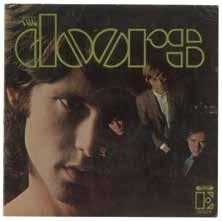
3068. The Doors Promotional Package. Extremely rare promotional package for ‘Break On Through (To the Other Side),’ the first single from The Doors, which was issued by Elektra Records in late 1966 in conjunction with the release of the band’s self-titled debut album and their appearance at the Fillmore Auditorium in San Francisco, California, on January 6, 1967. The package is comprised of a mono album proof cover for ‘The Doors’ debut album, with the interior featuring a taped 45 RPM single record for ‘Break On Through (To the Other Side) / End of the Night,’ and the adjacent side bearing an affixed concert poster, with psychedelic lettering that reads, “Elektra Records Introduces The Doors, will open with Sopwith Camel and Young Rascals,” and caption to lower border: “The Doors will open at 8:30 for all who present invitations.” Next to the single record an Elektra representative has added a note in black felt tip, “John: See you Friday, Thanks, Pete.” In fine condition. Elektra produced a very limited number of these packages to promote the band and invite press and retailers to witness the Doors’ Fillmore debut performance; this is one of a very small number to have survived. Starting Bid $300
Signed at Hendrix’s only in-store autograph session: Cologne, Germany, 1969

3069. Jimi Hendrix Signed Promotional Photograph. Exceptional vintage 4 x 5.75 cardstock promo photo produced especially for a one-off concert at the Sporthalle in Cologne, Germany, on January 13, 1969, prominently signed in black felt tip, “Jimi Hendrix.” Jimi did an in-store signing at the Du Monde Book & Record Shop in Germany on January 13, 1969, where he signed these promo card photos to promote his concert appearance later that evening at the Sporthalle. In very good condition, with heavy overall creasing. Accompanied by a certificate of authenticity from Tracks.
The autograph session at the Du Monde Book & Record Shop was the only in-store signing that Hendrix ever did—had it occurred in New York or London, it would have been absolute pandemonium. News footage of the event shows a relaxed atmosphere as he signs these special promotional cards for fans, with sketch artists also covering the event. Later that day, the Jimi Hendrix Experience performed a fantastic set that included ‘Foxy Lady,’ ‘Voodoo Child,’ and ‘Purple Haze.’ Starting Bid $1000
Signed at the world famous Tower Records on the Sunset Strip
3070. Bob Marley Signed Photograph. Outstanding vintage glossy 8 x 10 Island Records promotional photo, signed and inscribed in black felt tip, “Lyn, One Love, One Rasta, Bob Marley.” In very good to fine condition, with overall creasing. Accompanied by a statement of provenance from the brother of the photo’s recipient stating, in part: “My brother worked as a buyer at the most famous Tower Record…Bob was in the store promoting an album and my brother received an autographed photo. My brother’s name was Lynn… As you can tell, Bob misspelled Lynn’s name…My brother was too nervous to point out the mistake.” Marley photos of any size are scarce, particularly in 8 x 10 photos. Starting Bid $500
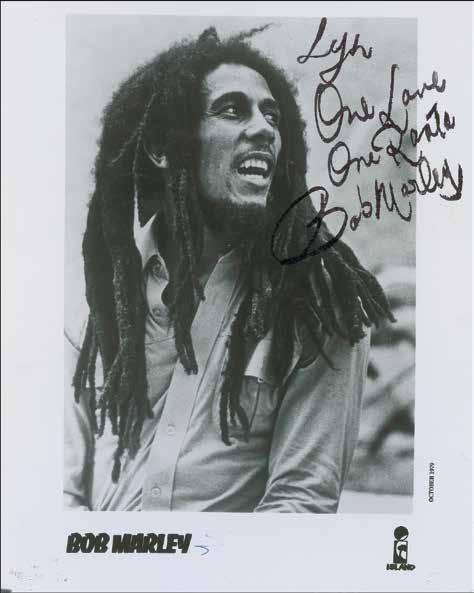

3071. Elton John Signed Album. Goodbye Yellow Brick Road album by Elton John, signed neatly on the front cover in black ballpoint. In very fine condition. The record is included. Accompanied by a certificate of authenticity from Tracks and by a typed letter of provenance from the original recipient: “In 1978 I opened an interior design, property renovation, fabrics, ornaments, lighting etc. shop in Primrose Hill…My general assistant, buyer, designs etc, was Susan Hall. Her husband was John Hall. He worked for Rocket Records...John asked me to handle various alteration works within the building. John Reid—Elton’s ‘manager’ ran the company and I negotiated and took instructions from him. One of the latter jobs was to gut part of the basement and build a bedroom and bathroom for Elton to use when he stayed over…As often, when settling accounts, taking instructions etc., we were sitting in John Reid’s office and he passed over to me, the Goodbye Yellow Brick Road, which he said Elton had signed and sent to me as a small thanks for the works.” Starting Bid $200
Vicious, the Sex Pistols, and Russ Meyer’s unfinished biopic from 1977


3072. The Sex Pistols Document Signed. DS, signed by all four members: “John Lydon” (Johnny Rotten), “John Beverley” (Sid Vicious), “Stephen Jones,” and “Paul Cook,” two pages, 7.5 x 9, October 10, 1977. Official letter from Warner Bros. Records to the Sex Pistols’ management company, Glitterbest, Ltd., seeking to modify a “Letter Agreement” that guarantees filmmaker Russ Meyer $77,000 “derived from the exploitation of The Picture in the United States and Canada,” and a “Recording Agreement,” which states that if the studio does not receive at least $150,000 it has the right to deduct no more than $20,000 per album from advances given to the band for a prearranged three-album deal. Signed at the conclusion in black ballpoint by the Sex Pistols. Double-matted and framed with a Warner Bros. publicity photo of the band to an overall size of 21.5 x 25.5. The document is in fine condition; the photo shows signs of toning and silvering. Two months after A&M Records broke contract with the Sex Pistols, the band signed with Virgin Records in May of 1977, and on October 10th signed a contract with the label’s American distributor, Warner Bros. Records, for £22,000. Never Mind the Bollocks, Here’s the Sex Pistols, the band’s only studio album, was released on October 28th and a week later debuted at number one on the UK Album Charts. The referenced Russ Meyer “Picture” was the unfinished film Who Killed Bambi?, which was intended to be the Sex Pistols’ introduction to the American market. The film was cancelled just after a day and a half of shooting, with camps from either side blaming the other: Meyer declared that Sex Pistols manager Malcolm McLaren ‘made false promises of financing and was broke,’ and McLaren in turn stated the the film’s studio, 20th Century Fox, withdrew support after reading the screenplay written by Roger Ebert. Starting Bid $300
In the hand of Kurt, Nirvana’s setlist for the 1991 ‘Rock for Choice’ benefit show
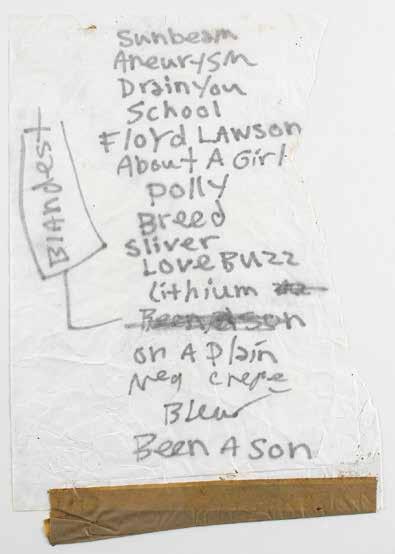
3073. Kurt Cobain Handwritten Nirvana Setlist. Soughtafter setlist written by Kurt Cobain for Nirvana’s appearance at the inaugural ‘Rock for Choice’ benefit concert held at the The Palace in Los Angeles, California, on October 25, 1991, unsigned, penned in black felt tip on an off-white 8 x 10.75 sheet, which features a total of 16 songs: “Sunbeam,” “Aneurysm,” “Drain You,” “School,” “Floyd Lawson,” “About a Girl,” “Polly,” “Breed,” “Sliver,” “Love Buzz,” “Lithium,” “Been a Son,” which has been struck through and replaced with “Blandest,” “On a Plain,” “Neg Crepe,” “Blew,” and “Been a Son.” Bottom edge retains the original packing tape, which was affixed to the side of a stage amplifier. In very good condition, with missing right side and overall creasing. Includes an original ticket stub to the concert. Accompanied by a full letter of authenticity from REAL. This incredible piece of grunge rock history was recently held at the Rock and Roll Hall of Fame with loan agreements. The first Rock for Choice concert was held at the Palace on Vine Street in Hollywood, California on October 25, 1991, and featured Nirvana, Hole, L7, and Sister Double Happiness as performers. Concert attendees were encouraged to speak out about women’s issues from a politically progressive angle, especially abortion rights, subject matter Cobain—a vocal supporter of the pro-choice movement—would later use for the song ‘Pennyroyal Tea.’ Prior to the concert Cobain received death threats from a small number of anti-abortion activists, with one threatening to shoot Cobain as soon as he appeared on stage. Setlists written in the hand of Cobain are exceedingly rare, with this particular example all the more significant given its relation to the famed Rock for Choice concert.Starting Bid $1000
Barnum writes to Bailey regarding “a couple of boxing monkeys”
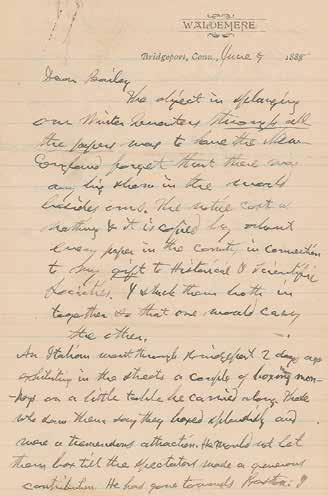

3074. P. T. Barnum. ALS, one page both sides, 6 x 9, Waldemere letterhead, June 5, 1888. Letter to his business partner James Anthony Bailey, in part: “An Italian went through Bridgeport 2 days ago exhibiting in the streets a couple of boxing monkeys on a little table he carried along. Those who saw them say they boxed splendidly and were a tremendous attraction. He would not let them box till the spectators made a generous contribution. He has gone towards Boston. I could get a friend there to get his address (for another year) or perhaps hire him next winter to train some monkeys for us. Or possibly our pig & monkey trainer could do it for us in some way. I have no doubt it would show well & tickle the people in our ring or on the stage next season.” In fine condition, with a light, rusty paperclip impression to the top edge. Great showbiz content from a pioneer in promotion. Starting Bid $200
Colorful 1934 letterhead promising a program with “Mickey Mouse, Minnie, the Three Pigs, Donald Duck”

3075. Walt Disney. Fantastic TLS, one page, 8.5 x 11, Walt Disney Productions/Mickey Mouse letterhead, March 19, 1934. Letter to May C. Lester, in part: “It is gratifying and encouraging to know that we have an unknown friend who is enthusiastic enough about our work to write us a note of appreciation. You may be sure that we all enjoyed our evening at the broadcasting station, and we are planning another program to be given some day when Mickey Mouse, Minnie, the Three Pigs, Donald Duck, and all the other members of our happy family can take time enough away from their picture making to go along with us.” In fine condition. Accompanied by the original mailing envelope. Superior content, an early date, and wonderful illustrated letterhead make this a must-have Disney piece. Starting Bid $500
Important early television contract for Monroe, signed on the eve of superstardom

3077. Marilyn Monroe Document Signed. DS, two pages, 8.5 x 14, March 2, 1949. An official letter of partnership addressed to the William Morris Agency, which reads, in part: “1. I hereby engage you as my sole and exclusive personal representative and adviser in the television field throughout the world for a period of three years, commencing on the date thereof. 2. Your duties hereunder shall be as follows: To use all reasonable efforts to procure employment for me in those

branches of the television field in which I notify you that my services are or will be available,” with Monroe agreeing to pay “a sum equal to ten percent (10%) of the gross return from the television field earned or received by me.” Signed neatly at the conclusion in fountain pen by Marilyn Monroe, and countersigned by agent Samuel Parks. In fine condition. A remarkably early Monroe contract relating to her careerturning partnership with William Morris. Starting Bid $1000
Exquisite early portrait of Marilyn

3078. Marilyn Monroe. Beautiful vintage matte-finish 10 x 8 photo of Monroe in a glamorous early pose, signed and inscribed in fountain pen, “To Lois McCann, Best Wishes Always, Marilyn Monroe.” In very good to fine condition, with a light crease to the upper right background area, and some small stains (two tiny stains to her face, and several more on her shoulder and arm). Encapsulated in a PSA/DNA authentication holder. Starting Bid $1000
Royals go racing—one-of-a-kind disclaimer signed by Diana, William, and Harry
3079. Princess Diana. DS, one page, 16.5 x 11.75, no date. Disclaimer document for go-cart racing at Playscape Pro Racing Ltd in London in which Prince William, Prince Harry, and Diana agree to the terms and conditions set forth. Signed vertically in the far right margin in black ballpoint by the princess, “Diana,” and signed in the table by both princes. William writes, “P. William, Kensington,” and adds a messy cursive signature, while Harry simply writes, “Harry,” in two columns. In fine condition, with intersecting folds and small edge tears. Starting Bid $200

Lombard’s remarkable twice-signed driver’s application

3080. Carole Lombard Driver’s License Application. Rare DS, one page both sides, 4.75 x 8, March 25, 1937. State of California-Department of Motor Vehicles duplicate operator’s application filled out in Lombard’s hand and signed on the front and back in black ink. The 28-year-old actress has reapplied for her license noting that the first one was stolen. On the front side, below her signature, Lombard lists her address (5451 Marathon, Hollywood), height (5´-5.5˝), weight (112 lb.), eye (blue) and hair color (blond), and answers several questions regarding her health and driving ability; she pens her parents’ names on the reverse below her second signature. In fine condition. Following a new $450,000 deal with Paramount Pictures, Lombard became the highest-paid star in Hollywood in 1937, acting in three films that year: Swing High, Swing Low; Nothing Sacred; and True Confession. Just a few years later, at the age of 33, Lombard and twenty-one others, including her mother, tragically perished in a plane crash near Nevada’s Potosi Mountain. A one-of-a-kind format signed by an adored Hollywood actress who remains highly sought after. Starting Bid $200
Tux shirt and silk bow tie worn on stage by Frank Sinatra

3081. Frank Sinatra Stage-Worn Shirt
and Tie. Sensational stage-worn combo of a Nat Wise tuxedo shirt and Washington Tremlett butterfly bow tie personally-owned and -worn by entertainment icon Frank Sinatra, both of which are attractively displayed in a shadowbox frame measuring 24 x 27.25 x 2.75. Accompanied by signed letters of authenticity from Sinatra’s former co-manager, Tony Oppedisano, and his personal aide and costumer, Michael Castellano. Also includes a photograph signed and inscribed to gossip columnist Aileen Mehle, an ALS by Mia Farrow, and an assortment of photographs and ephemera. A superb grouping of items from the late 1960s—the pinnacle of Frank Sinatra’s career. A comprehensive description of the lot is available online at RRAuction.com. Starting Bid $500

Apocalypse Now contracts signed by Colonel Kurtz
3082. Marlon Brando ‘Apocalypse Now’ Documents Signed. Two film contracts signed by Marlon Brando for the 1979 film Apocalypse Now: a screen credit release waiver, December 1, 1977, submitted to Coppola Cinema Seven and signed at the conclusion in ink by Brando, who agrees to “waive the rights which I have to receive credit on the screen from my services rendered in connection with the film” and the second document, July 18, 1979, which concerns “screen and paid ad purposes, as well as subsidiary rights exploitation and advertising,” and is signed twice at the conclusion in ballpoint by Brando, who approves four stipulations. In overall fine condition. Starting Bid $200

Iconic helmet from the Platoon theatrical poster, with ample provenance from photographer

3083. Platoon Helmet from Original Theatrical Poster. Amazing original M1 combat helmet pictured on the theatrical poster for the Oscarwinning 1986 war film Platoon, measuring 11˝ x 7.5˝ x 9.5˝, with the iconic camouflage-pattern helmet cover bearing assorted scuffs and rips and emblazoned on the left side in bold black felt tip: “When I die bury me upside down so the world can kiss my…” The helmet retains its original chinstraps, but the horizontal strap, ace playing card, and peace sign necklace are not included. The inside of the helmet is signed in silver ink by the poster photographer, David Spindel, who is perhaps best known for photographing John Lennon and Yoko Ono during Lennon’s last recording sessions for Double Fantasy in 1980. Also included is an alternate ace playing card that was one of handful used for the photo shoot, and a massive color satin-finish 36 x 53.5 poster for the Oliver Stone film, which is signed in silver ink by Spindel. In fine condition. Accompanied a press kit for Spindel, containing six signed photos, and a signed letter of provenance that shows Spindel holding the helmet. A magnificent, museum-quality piece of cinema history. Starting Bid $500
Hef hopes to tap Caldwell, Huie, and O’Hara for Playboy—then called ‘Stag Party’
3084. Hugh Hefner. TLS signed “Hugh M. Hefner,” one page, 8.5 x 11, Stag Party letterhead, September 19, 1953. Letter to Charles B. Blanchard of Little, Brown & Company, in part: “Thank you for your letter...with the information on The Indoor Bird Watcher’s Manual and the good news about Erskine Caldwell’s stories. I am interested in ‘The Courting of Susie Brown,’ ‘The Night My Old Man Came Home,’ ‘New Cabin,’ ‘Autumn Courtship,’ ‘Over The Green Mountains,’ ‘Carnival’...I hope these are available and that most of them fall at the lower end of the fee range you mention.” He goes on to inquire about permission to use stories by William Bradford Huie and John O’Hara.” In fine condition, with a short tear to the upper left edge. Starting Bid $200

Rare candid photograph of Oskar Schindler, annotated on the reverse by the WWII hero
3 0 8 5 . O s k a r S c h i n d l e r
Hand-Annotated Photograph. German industrialist (1908–1974) credited with saving almost 1,200 Jews during the Holocaust by employing them in his enamelware and ammunitions factories. Color vintage glossy 3.5 x 3.5 photo of Oskar Schindler seated between two friends while visiting America in 1957, annotated on the reverse in Schindler’s hand. In very good to fine condition, with a tear to the upper right edge, passing through the top of the lampshade. Encapsulated by Beckett Authentication Services and accompanied by a full letter of authenticity from Beckett. Accompanied by several documents from the lives of Oskar and Emilie Schindler. Starting Bid $300


Scarce 1789 document lengthily endorsed by Marie Antoinette

3086. Marie Antoinette Document Signed. Vellum manuscript DS in French, signed “Marie-Antoinette,” one page, 15.25 x 10.5, November 20, 1789. A debt acknowledgment related to expenses from six years prior, in part (translated): “Marc Antoine Francois Marie de la Tour, administrator of the Royal Treasury, in charge of our household expenditures has paid for the year 1783 the amount of 32,000 livres to our lady-in-waiting for our tissues and clothes.” Marie Antoinette certifies below with three autograph lines: “Receipt of the amount of thirty two thousand livres given to us in our hands during the year seventeen eighty three. Marie-Antoinette.” Countersigned by her secretary Beaugeard. A scarce paper seal depicting Marie Antoinette’s coat of arms is present to the lower left. Affixed to a slightly larger sheet and in very good to fine condition, with rippling and toning (primarily to the edges) and a tear to the left blank area. Starting Bid $1000
Handmade ‘Jack the Ripper’ jacket from Lee Alexander McQueen’s graduate collection

3087. Alexander McQueen ‘Jack the Ripper’ Jacket. Supremely rare jacket hand-made by Lee Alexander McQueen for his 1992 Central Saint Martins graduate collection, ‘Jack the Ripper Stalks His Victims.’ While this piece was not chosen for the runway, is especially rare and historic as a genuine piece from his graduate collection; all other known Jack the Ripper pieces from the show were famously purchased by McQueen’s mentor, Isabella Blow. There are characteristics of his expert cut and tailoring from Saville Row executed here, including his own new flourishes as a designer: the shoulders are bunched in the back, and the sleeves are lined with gorgeous Victorian mourning lilac fabric. This was a trademark color of McQueen’s, and evidence of his obsession with morbidity; it also aligns

with the show’s macabre Victorian-era ‘Jack the Ripper’ theme. The jacket features two diagonal front pockets, a two-button closure, and five-button cuffs. This piece was examined by Claire Wilcox (one of the world’s preeminent McQueen experts) and confirmed to be McQueen’s work, and considered for inclusion in the V&A’s Savage Beauty exhibition. As one of few handmade McQueen pieces to remain in private hands, it is of the utmost interest to scholars and serious collectors alike. In fine, wearable and showable condition, with evidence of general use from over 30 years of ownership. Provenance: from the Alexander McQueen Collection of Alice Smith, his first publicist, longtime friend, and muse. Starting Bid $2500
Exceptional twice-signed “Alphonse Capone” gold coin interest note

3088. Al Capone. Extraordinary partly-printed signed document, signed twice, “Alphonse Capone,” one page, 8.75 x 3, November 18, 1926. An interest note for “Loan No. 6223,” in part: “Due to the order of Ourselves…$45.00 in gold coin of the United States of America of the present standard of weight and fineness, on the 18th day of November A.D. 1930 without grace, at the office of Lawndale National Bank in the City of Chicago…with interest after maturity until paid, at the rate of seven percent, per annum, being for an installment of interest on our principal and note No. 6 being of even date herewith for the sum of $1500.00.” Signed at the conclusion by Al Capone, his mother Theresa Capone, and his wife Mae Capone, and also endorsed on the reverse by all three. Encapsulated by PSA/DNA. In fine condition, with a small area of paper loss to the left edge. Accompanied by a full letter of authenticity from PSA/DNA. Starting Bid $2500

Facing ten years or more, Dillinger tells his sweetheart not to wait
3089. John Dillinger. ALS signed “Johnnie,” one page both sides, 7.75 x 9.75, October 1, 1933. Letter to Mary Longnaker, written from Allen County Jail in Lima, Ohio, where he was held after being arrested following a string of bank robberies. In part: “I just read in the paper of Jimmy’s death and I know you must be heartbroken. I feel for you dear for I know how much you cared for each other, and I can understand your grief because Jimmy was the only real friend and pal I had...I wish I were free so I could take you away and make you happy but the least I can expect is ten years. Sweetheart if I had known two months ago that you would ever care enough about me to marry me I would have gotten a job, somehow for
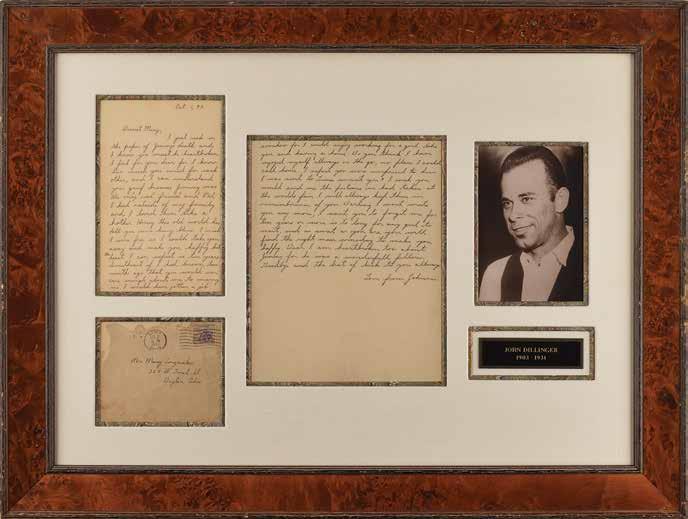
I could enjoy working for a girl like you and having a home... Darling I won’t write you any more, I want you to forget me for ten years or more is to long for any girl to wait, and as sweet as you are you will find the right man someday to make you happy.” Handsomely double-matted and framed with the original mailing envelope (addressed in Dillinger’s hand), a color copy of the front of the letter, a portrait, and a nameplate to an overall size of 27.5 x 20.75; the display has glass on both sides so that the full letter can be seen. In fine condition, with some mild creasing, and opening tears to the envelope. Starting Bid $1000

3090. Bartolomeo Vanzetti. ALS signed “Bartolomeo V.,” three pages on two sheets, 6 x 9.5, June 18, 1924. Letter to John and Virginia G. Bournan of Stephen City, Virginia. In part: “Justice must be done, my friends, and greater and greater will be the sacrifice of the lovers of liberty till her final triumph. My judiciary adventure was so vulgar, barefaced and evidently a premeditated legal murder—that to chained and killed from it—is something unspeakable. And yet, after having spended for years in prison and over $200,000 we are still as near to the electric chair as we were when pronounced guilty. They do what they like and they were rendered so unconscious and

degenerated by the deadly consequences and influences of their education, office and environment that only fear—the fear for the only three things which they hold as sacred: their purse; their power; and their skin—can stop them to satisfy they ferocy and greed—by any sort of offence and violences to the lovers of freedom and their old folks, women and children. Where not for your help and solidarity—for the world wide solidarity and protest—Nick and I would have been burn alive long ago.” In fine condition. Accompanied by an address panel accomplished in Vanzetti’s hand. Starting Bid $500
Remarkably rare winner’s medal from the first Olympic Games

3091. Athens 1896 Olympic Winner’s Medal. Winner’s medal issued for the Athens 1896 Summer Olympics. Bronze, 50 mm, 60 gm, by Jules Clement Chaplain. The front depicts a relief portrait of Zeus holding Nike, the goddess of Victory, in the palm of his hand, with text along left side, “Olympia”; the reverse bears a detailed view of the Acropolis of Athens topped by the Parthenon, with raised Greek characters to upper and lower portion (translated), “International Olympic Games in Athens, 1896.” Stamped “Bronze” on the edge. The upper loop was added at a later date.
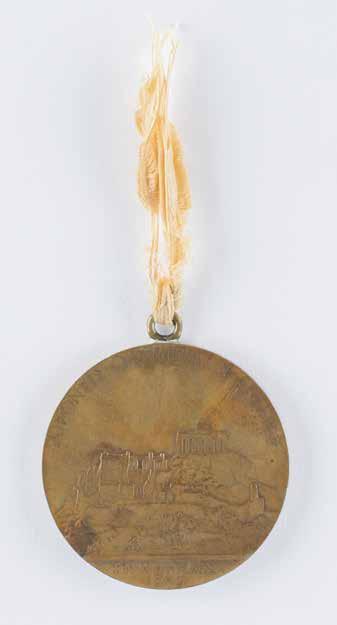
This highly sought-after winner’s medal was awarded to Greek wrestler Georgios Tsitas, who finished second in the GrecoRoman wrestling event at the first Modern Olympic Games. The medal is accompanied by a copy of an invitation from George I of Greece to attend an event at the Old Royal Palace, as well as two images of Tsitas in his prime and in later age. Winner’s medals from the historic debut of the Olympic Games remain exceedingly rare—this being the first we have ever offered—and are among the most sought-after accolades in the realm of sport. Starting Bid $5000

